


 |
July 4, 2008: 4th of July at Ron Mathis's House |
 |
June 13-16, 2008: The Texas Folklife Festival in San Antonio |
 |
Return to Index for 2008 |
This weekend, Fred and I are headed to Nashville and the first Dreamland Festival held by Whitley Strieber's Unknown Country website. This is one of the two websites that Fred and I listen to quite a lot; Coast to Coast (Art Bell) is the other. Whitley Strieber is the author of Warday (a copy of which I have), Communion, which I have read and, among many other works, The Master of the Key, a book which is one of Fred's favorites. The movie "The Day After Tomorrow" was based on Strieber's book The Coming Global Superstorm. Strieber is quite well-known in "weirdness" circles.
Also in attendance will be Whitley's wife, Anne, who has her own insights having been literally at death's door a few years ago, Jim Marrs, author of Inside Job, a book about the 9/11 conspiracy, Linda Moulton Howe, a frequent correspondent on Unknown Country dealing mostly with UFOs and alien encounters, and William Henry, who deals mostly with cultural things, like Stonehenge, the Mayan Culture, global control networks, Atlantis and the kind of connections that Dan Brown made famous with The DaVinci Code.
Fred was a bit surprised that I suggested we go when he pulled up an advertisement for the convention over a month ago, and I think he was a little pleased as well that I would devote an entire weekend and twenty hours of driving to indulge his curiosity about such things. But I thought it would be interesting too, and we both looked forward to meeting these folks we'd become so familiar with over the Internet. In the main, we weren't disappointed.
Thursday, June 26: Driving from Dallas to Nashville
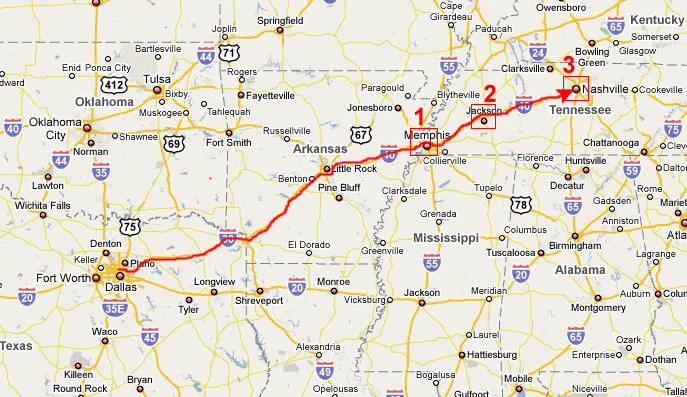 |
I've marked three locations on the map at left that I want to talk about in more detail below.
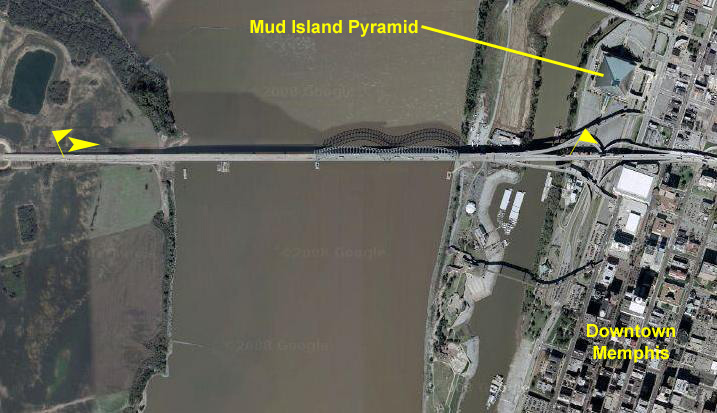 |
Just before we got to the I-40 bridge over the Mississippi River at Memphis, I pulled over to the side of the highway to get out my movie camera so I could record our progress over the river and into Memphis.
|
|
Once we crossed the river, we followed I-40 around the north side of Memphis and then continued on east through Tennessee.
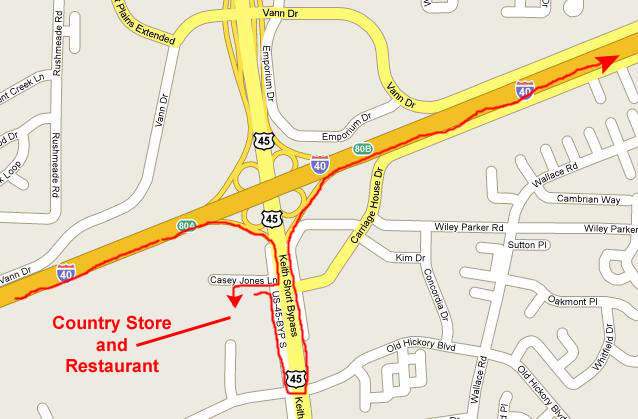 |
It was dinnertime when we reached Jackson, Tennessee, and so this being the last big town before Nashville, we thought we'd better stop and eat while we could. I pulled in to a motel to ask about local eateries, and the desk clerk pointed me to the nearby Old Country Store and Restaurant, and even gave us a coupon for a special rate on their dinner buffet.
We drove a couple of minutes around to the restaurant, and were quite surprised to find a rather large complex, consisting of the restaurant, stores and the Casey Jones Railroad Museum (Mr. Jones, apparently, either having been a resident of or born in Jackson). We were also surprised to find that, outside the restaurant/store, there were at least five different bluegrass music groups performing. There was no stage, or anything, the groups were just clustered either on the porch of the store or beside it or out on a grassy island in the parking area. Each was performing different selections using different instruments and different styles. And they were just far enough from each other that if you got relatively close a one particular group they weren't clashing with any of the others.
I thought about taking some movies of these groups right away, but had not brought my camera from the car (since we hadn't known the groups would be here), so we went on in to the restaurant to eat. The buffet was quite good (excellent barbecue), and our coupon got us $3 off the usual $9 price.
After we ate, I went back to the car to get my camera, and then I walked around to each of the bluegrass groups to see if I could get some good movies. For amateurs, the groups were really good, and were obviously enjoying what they were doing, and so the movies turned out quite well. You can use the movie players below to watch the movies I made of the various bluegrass groups outside the Country Store and Restaurant:
|
|
|
|
|
|
After looking at the various bluegrass groups, we took a couple of additional pictures outside. One of them was Fred with an Indian sculpture and the other was me in front of the Country Store. Finally, just before we left, I went back inside to look and see what kind of homemade candy I could find to eat in the car, and Fred took a movie of me looking over the selection and making my purchase; you can watch that movie below:
|
|
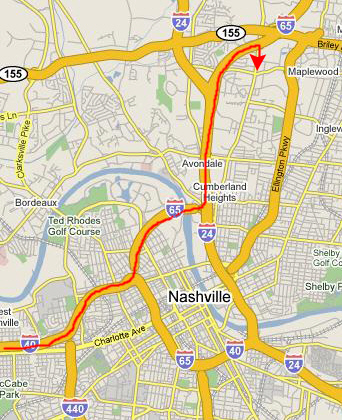 |
When we reached Nashville, we took I-65 north to the exit for Dickerson Pike.
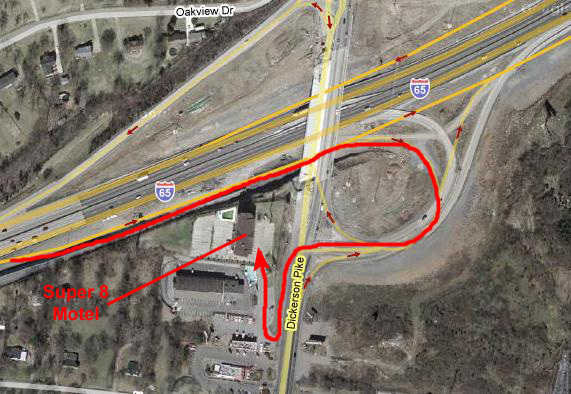
Our motel was located pretty conveniently on the north side of town at the intersection of I-65 and Briley Parkway- the loop around Nashville. We could get downtown in ten minutes, as it turned out, and the hotel was also convenient for the other excursions we took while here in Nashville.
Friday, June 27: Burgess Falls State Park
The Dreamland Festival did not begin until 7PM on Friday night, so I did some investigation on the Internet and found that there was a state park just about 40 miles from Nashville that had one of the prettiest and tallest waterfalls in the state of Tennessee, and so I planned a trip over there that would take us most of the day, but we would be back in plenty of time to get ready for the opening of the conference.
Getting to the Park
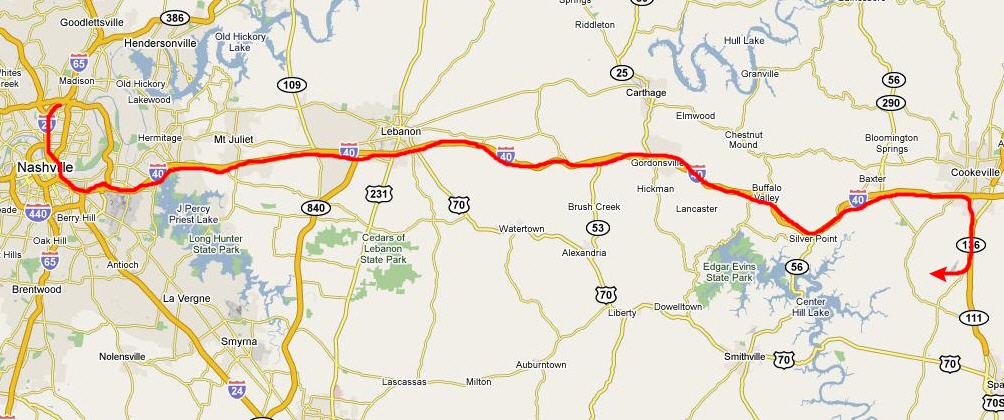
Getting to Burgess State Park was pretty easy. We took a slightly different route south through downtown Nashville, seen here from the expressway on its east side (see map). Nashville, as it turns out, has some very interesting architecture, architecture that we would see a lot more of on Saturday and Sunday. When we met up with I-40, we simply headed east on that Interstate. Just past the town of Gordonsville, the terrain changed from gently rolling hills to steeper, taller hills, and there were a number of rivers and creeks going beneath the highway. About five miles later we came to a Tennessee visitor center, so we stopped to take a look.
There was a small river running right by the center, but there was no good path down to it. On the lawn of the visitor center, there was an interesting sculpture which, according to the identifying marker was called "Marking Time." I think the whole thing was a large sundial, but we were not sure how it worked. In the half circle surrounding the dial, there were lots of silver markers which, as near as I can figure, had Tennessee counties on them. In this last picture, you can see that one of the markers has the name "Davidson" on it, and I believe that is the county that includes Nashville. But how they were arranged and why some of them were oriented differently and of different sizes escaped us.
After we'd looked around for a while, we headed on to Cookeville, where we got off the interstate and followed Tennessee highway 135 south about ten miles. The highway is called Burgess Falls Road here, and just across the Falling Water River we found the entrance road for the park itself.
Orientation to the Park and Trails
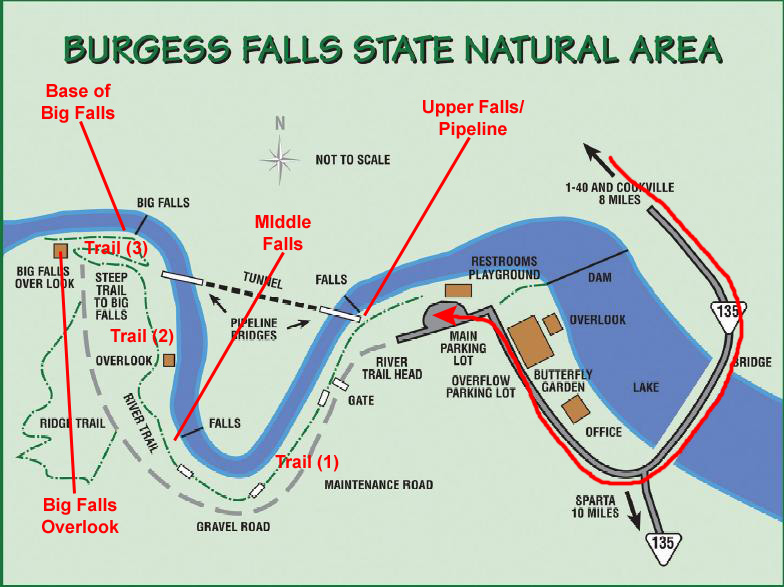 |
Each of the marked locations or sections will have its own section of pictures below, and the titles of those sections will match the titles on the map.
The sections will contain the pictures and movies we took (1) at the upper falls and old pipeline, (2) along the trail from the upper falls to the middle falls, (3) at the middle falls, (4) on the trail to the big falls overlook, (5) at the big falls overlook, (6) on the trail down to the base of the big falls and (7) at the base of the big falls.
Upper Falls and Old Pipeline
|
|
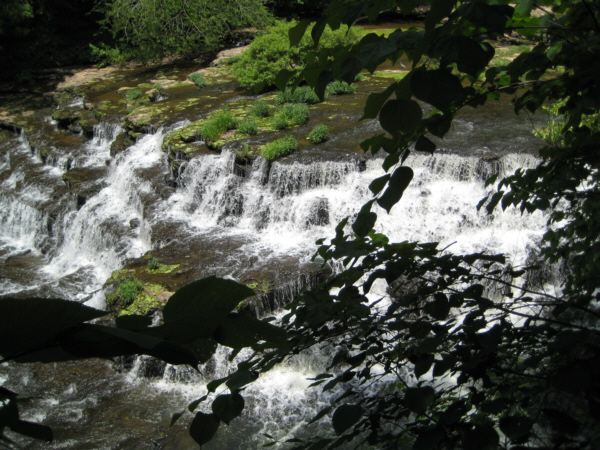 |
Walking another couple hundred feet down the trail brought us to the overlook for the first set of falls we encountered. The falls here don't seem to have actual names, unless "Big Falls" is an actual name, so we'll just call this first set of falls the "upper falls" for want of an official name.
|
|
Trail (1): From the Upper Falls to the Middle Falls
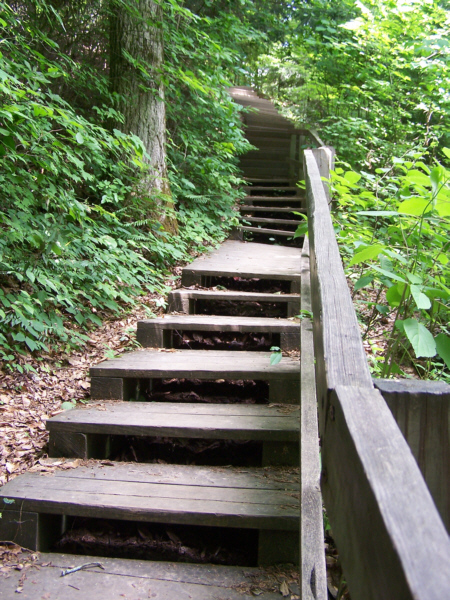 |
|
|
After I was already a ways past the rock overhang, Fred called me back to get a still picture of me at the overhang.
As we walked along the trail, we passed some interesting features, including this this small spring that was feeding a small amount of water into the Falling Water River, which, occasionally, we could see through the trees as we walked along. As we crossed in front of this small creek, a wooden bridge carried the trail over the stream to continue on through the forest.
|
|
The Middle Falls
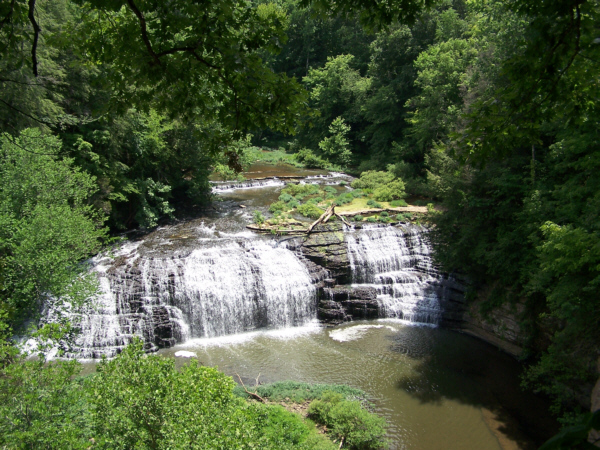 |
The narrative in my movie of the middle falls (below) will explain something of our impressions of what we looked at which was, any way you slice it, a really impressive waterfall- even now, with most of the spring runoff long gone.
|
|
|
|
We took more pictures of middle falls, and I have put thumbnails for some of them below. Just click on the thumbnails to look at the full-size pictures:
|
Trail (2): Hiking from Middle Falls to the Big Falls Overlook
Big Falls Overlook
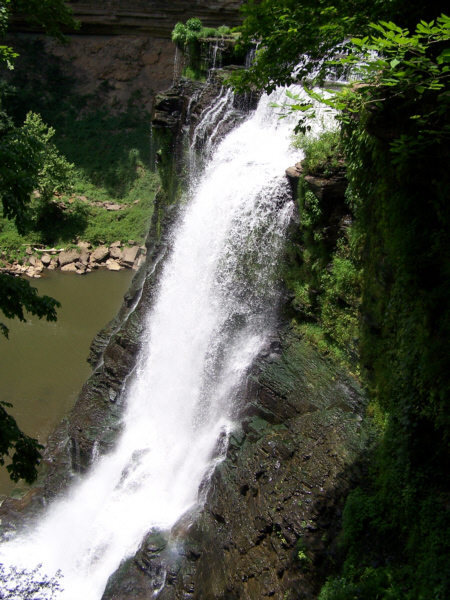 |
There was a short trail from the overlook platform down to the level of the river at the top of the falls, and so we went down that trail to see what different views we could get. The end of the trail, which came out onto the flat rocks above the falls, afforded a side view of Big Falls, now tough to get into frame since we were so close. Fred also thought the top of the main cascade interesting enough to take a picture of.
I, of course, had to walk out onto the flat rocks above the falls. There, I was standing on the same tough strata that was only very slowly being eaten backwards by the falls. From here, I could get a complete picture of the Falling Water River here at the top of Big Falls. Looking upstream from my position, the river appears tranquil as it flows through the forest and grasses lining the banks. Then, it continued its leisurely pace around in front of me and downstream to my left. Walking in that direction, I came out onto a bare rocky area, where you can see the river flowing across a series of small steps, just beginning to give indication of the surprise to come. Then, in just a few more feet, it is over the falls.
I wanted to go out further onto the flat, dry rocks at the top of the falls, and with Fred's admonition to stay away from the edge ringing in my ears, I did just that. When I got out to the edge of one of the top shelf formations, I thought I would take a movie of the scene in front of me. Fred's admonition quite forgotten already, I got rather closer to the edge than Fred would have liked, as you can see when you watch my movie below, right:
|
|
|
|
Trail (3): To the Base of Big Falls
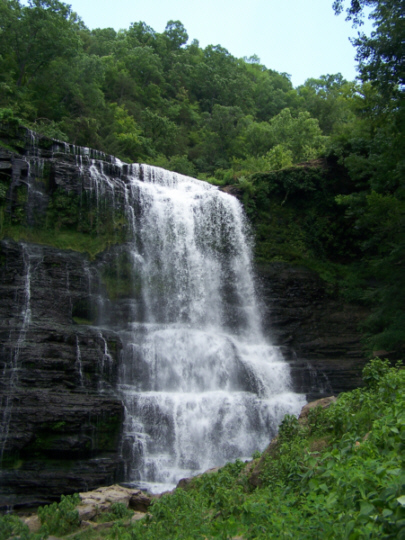 |
From this point, the trail led to another set of stairs that you can see in pictures here and here- this one enclosed in a mesh canopy- probably to keep people from tossing stuff down to the bottom of the falls and potentially hitting someone who might we walking around down there- and from there to another overlook about midway down the height of the falls. As soon as we reached that overlook, I stopped to make a movie of Big Falls and the canyon opposite as seen from this spot, and you can watch that movie using the player below:
|
|
This turned out to be a good vantage point for some pictures of the largest cascade, and you can see some of the best pictures we took from this overlook (the fourth one actually having been taken almost from the bottom of the trail down) if you will click on the thumbnails below:
|
At the Base of Big Falls
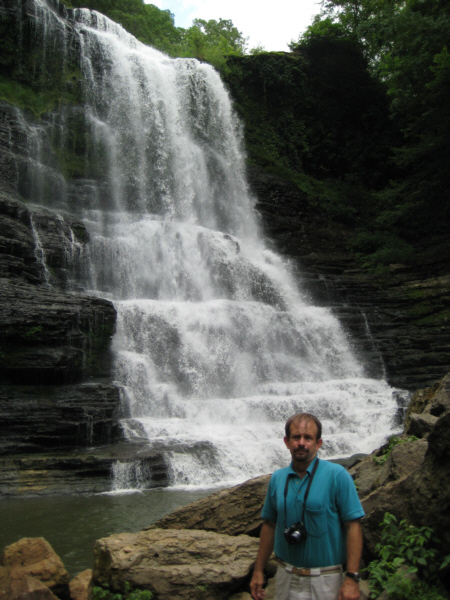 |
The views we got of the falls from the bottom were really amazing. Both Fred and I got shots of the upper part of the cascade close-up, and you can see those two pictures here and here. Fred focused in on the rocky outcropping that divided the two main waterfalls. To me, it looked as if there were some kind of carved logo up towards the top.
From the base of the falls, here is a view of the canyon wall on the other side of the river below the falls, and also a look downstream past some of the people sitting there admiring the view.
I also took another movie of the falls and the course of the river downstream, and you can watch that movie using the player below:
|
|
We wandered around the base of the falls for quite some time; after all, we'd come far enough to get here that we wanted to enjoy the moment. As we climbed around, we took numerous other views of the falls from various angles, and I have put thumbnails for some of the best of these views below. I know that some of the views might be similar, but it was hard to winnow down the many pictures to just the seven I've included here. Just click on the thumbnails to view the full-size images:
|
The hike was a lot of fun, but we did have something of a deadline, so while we could have stayed at the base of the falls for some time (and I was sorry I hadn't brought a bathing suit and towel), we headed on back up the trail to the overlook, and from there worked our way back to the parking area.
We headed back north on Route 135 to the interstate, pausing at a nursery we'd passed on the way down so Fred could look at their day lilies. He bought a couple to bring back to Texas and grow himself. We stopped at a local restaurant in Cookeville and had their lunch special, and then got back on I-40 to Nashville.
When we got to Nashville, we took a different route back to the hotel- around the belt loop expressway (Briley Parkway)- and got back to the Super 8 about four-thirty. We relaxed for a while and then got cleaned up and ready to leave for the opening of the Dreamland Festival.
Friday, June 27: The Opening Session at the Dreamland Festival
We left the hotel about six; we wanted to get to The Nashville Public Library- the site of the Dreamland Festival- well ahead of the 7PM start time so we would not only get good seats but also, perhaps, get the books we'd brought with us autographed.
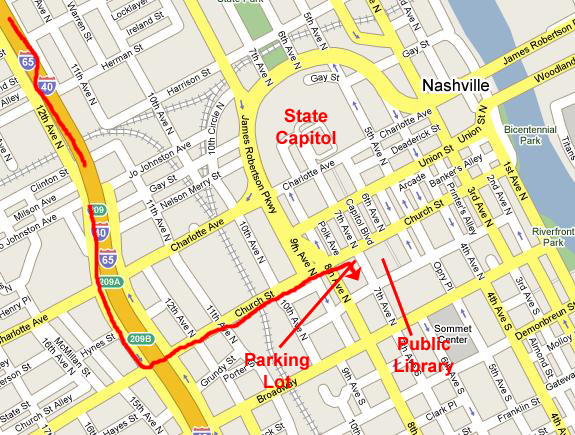 |
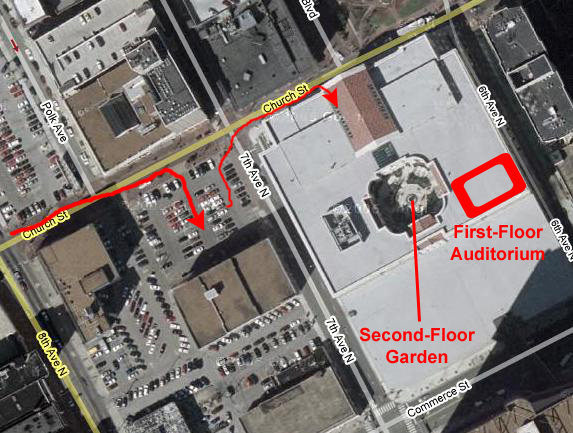 |
There were signs directing us to the back southeastern corner of the building where we found the registration desk. As promised, they had our names on file, so we got our nametags and information packets and went on into the auditorium to get some seats.
Fred had wanted to get their early because Anne Strieber had promised, on the UnknownCountry website, that she would have a special gift for the first forty people she saw wearing green shirts, and of course Fred wore one. She was just outside the auditorium, and he got his gift- a signed little essay by her.
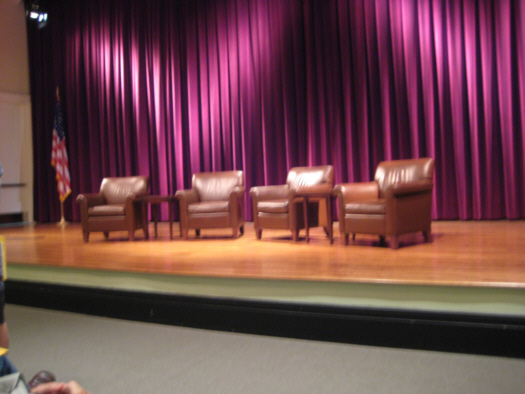 |
|
|
You can see in that movie a gentleman (who turned out to be from Arlington, Texas) chatting with some of the attendees. We saw him frequently during the weekend; he was one of the chattiest, most outgoing people there. He came over to talk to us as well, and just before he moved on to someone else, I had him take our picture. Unfortunately, we turned out a bit fuzzy.
|
|
And then the event began.
First up was William Henry, one of the people who appears on UnknownCountry regularly. He is a Nashville resident, and he attended to all the housekeeping and event announcements this evening.
|
|
Next up this evening was Anne Strieber, and her topic for an hour was alien abductions. She, herself, does not claim to have been abducted, but she has interviewed many persons who do so claim, and her topic was what these experiences seem to have had in common. Then, Whitley Strieber talked for an hour about how his own experiences have shaped his thinking about "strangeness," and why UnknownCountry.Com is such a labor of love for him. Finally, both Whitley and Anne Strieber took the stage for a question and answer period, which was very interesting. I made a movie of one of the stories that Strieber told; watch it below:
|
|
One of the questions had to do with UFOs, so Whitley turned to another one of the speakers who is on his site frequently- Linda Moulton Howe- who answered the question from the side of the room. I think it might have been more effective had she and Henry been on stage as well, but I suppose Strieber was the "star" of this particular event. Certainly, I think, a lot of the attendees came a long way just to meet HIM.
|
|
Zippy's also had live entertainment, and was pretty busy, so I made a movie to show you what it was like. You can watch that movie using the player at right.
Saturday, June 28: Outside the Nashville Public Library
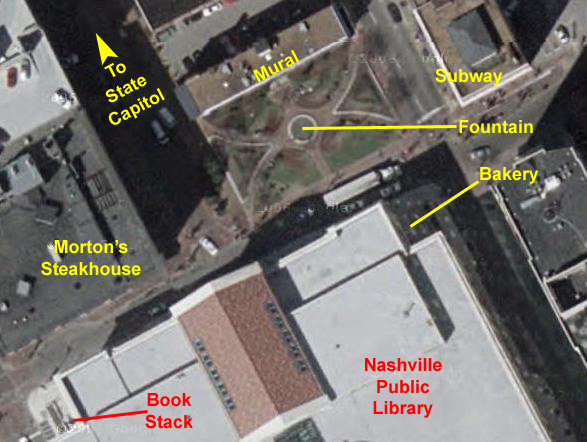 |
The mural on the side of the building that abutted the park was very clever and very well done. It looks as if a couple of men on a window washer's platform are putting a puzzle together on the side of the building. Some pieces are already in place, and some are being brought up to be placed. In this closeup of the mural you can see the effort the artist put into this to get the details right. Notice the shadows of the men and their platform, and even of the rope being used by one of them to bring up another puzzle piece. All very neat and very well executed.
Right in the middle of the little park is a nice fountain, and both Fred and I used that fountain and the part of the mural behind it as backdrops for pictures of each other; you can look at those pictures here and here. Notice that in the archway that is part of the mural, the artist even painted the reflection of the library across the street, as if the archway were a giant mirror.
Just before the doors to the library were opened, Fred, standing on the sidewalk outside the library, took a picture directly up 6th Street look at the Tennessee State House, a place would visit late this afternoon after the sessions were over.
Saturday, June 28: The Morning Session of the Dreamland Festival
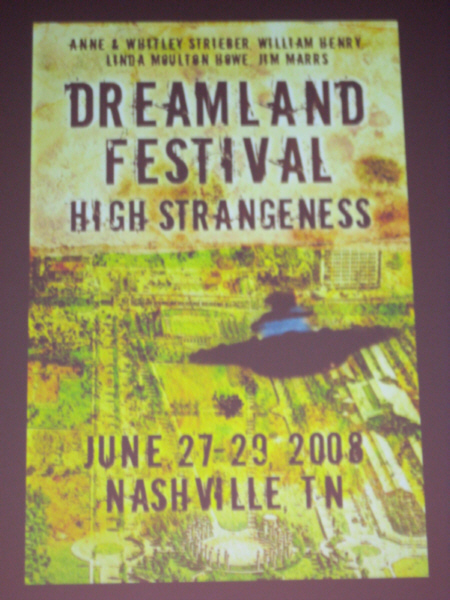 |
I couldn't quite follow a lot of Henry's presentation, although it seemed as if much of the audience did. Like many of the guests on UnknownCountry.Com, he tended to ramble a bit and assume a lot of knowledge on the part of his audience. But what he had to say was interesting- particularly the parts about why Nashville is laid out the way it is, and how many of its famous buildings came to be located where they are.
|
|
Just after signing my book, someone else asked Whitley and Anne to sit together for a snapshot. Recognizing an opportunity, I ended the movie and switch to picture mode to get two good candid snapshots of Whitley and Anne Strieber, and you can see those pictures here and here.
I went back and collected Fred and we headed over to the Subway sandwich shop for lunch.
Saturday, June 28: The Dreamland Festival: Afternoon Sessions
Linda Moulton Howe
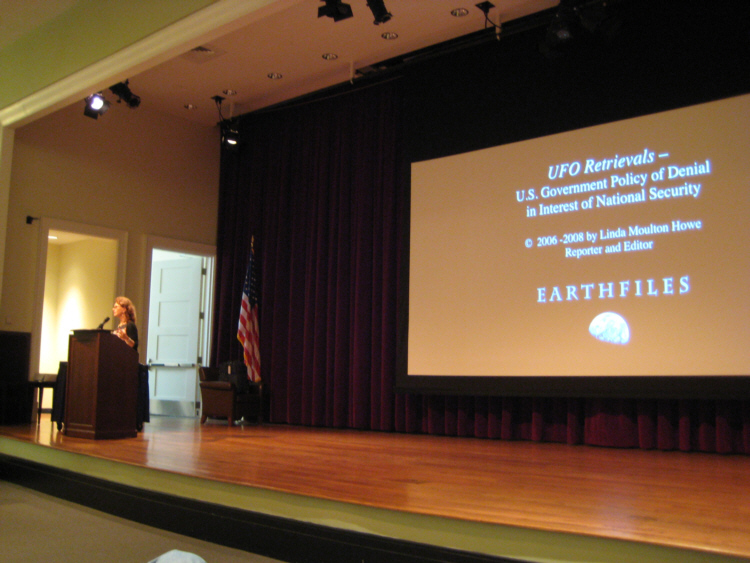 |
Anyway, Howe took us through the operations following the "crash" in Roswell, and showed us excerpts from some previously little-known documents, ostensibly prepared by a secret committee formed in 1947 by President Harry Truman, called "Majestic 12" or "MJ-12" or just "MAJIC."
These documents, if authentic, lend much credence to the conspiracy theories surrounding alien visitations and Area 51 and all of that. An Internet search, mostly on Wikipedia, seems to indicate that there is no conclusive evidence that these documents are either all fakes or all genuine. What is undeniable is that they are all interesting, as was Howe's presentation. Most of the documents seemed to be from the 1947-1948 timeframe, when UFOs were on everyone's mind. All these documents had the look of having been prepared on old manual typewriters, but this could have easily been simulated. Some of the last documents she showed us seemed to be more recent; the last two pictures below are examples. You may not be able to read the last one very well, but the topic titles and the stamp at the bottom of the page are interesting enough.
Take a look at some of these excerpts that Linda Moulton Howe showed us by clicking on the thumbnails below:
 |
 |
 |
 |
 |
Jim Marrs
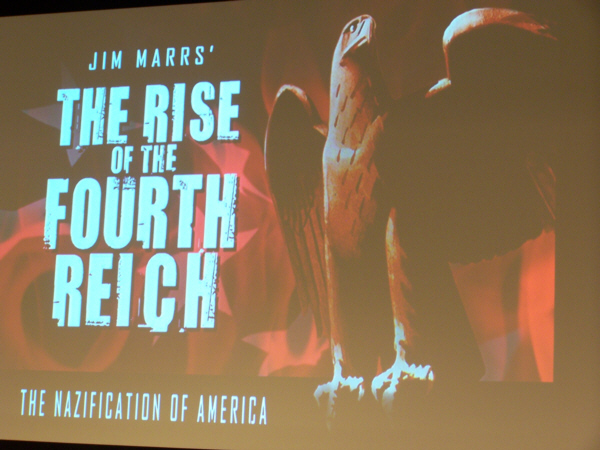 |
He started with some definitions, and then took us on a trip through the history of up to and including World War II. He then drew parallels between what happened there and what is happening, according to him, here. The parallels WERE pretty dramatic, except that fascism circa 2008 is a lot more technologically-oriented than myth-oriented. But the end result is the same; corporate power has eclipsed the power of the people (and of course that very issue is a cause celebre among liberals today- e.g., "Big Pharma").
I found Marrs's presentation only slightly less interesting than Howe's, although actually more relevant, since there is a lot more evidence for American fascism than there is for alien visitation. We tried taking a lot of pictures of Jim during his presentation, but none of them turned out well.
I did take a couple of movies of segments of his presentation though, and I think these will actually give you a better idea of what it was like than pictures would have. You can watch these movies using the two movie players below:
|
|
When Marrs' presentation was concluded, the Fred could use his flash, he did get one picture of Marrs with his new book in hand.
Whitley Strieber
The last presentation of the day was given by Whitley Strieber, and it was actually not a presentation at all but rather a meditation session led by him. He and his wife have been through a great deal since the publication of his book, Communion. While it sold well, and he made a name for himself in such circles, his fame brought him to the intention of the creators of "South Park." After a scathing episode in which he was made fun of, by name, when Cartman was abducted and probed anally, Strieber found his effectiveness had been destroyed- at least for the mass audience. He and Anne went through bankruptcy, apparently, and eventually moved to a small place in Los Angeles. With UnknownCountry.Com and his recent books and movies, he is making a comeback, but it has been hard.
Meditation, he told us, has helped enormously, and he took the time to take us through his particular procedures. I can verify that, at the very least, they were relaxing, as I promptly fell asleep. Anyway, it was a very interesting day, and it was a great deal of fun to meet these folks I have heard online so often.
Saturday, June 28: Inside the Nashville Public Library
 |
We walked up the stairway to the third floor, and looked through the windows there out into the garden, and I took a picture looking towards the front of the building into one of the special collections galleries. Back down on the second floor, we walked towards the front of the building through one of the reading rooms to the windows at the front of the building. From here, looking out through the center window of the entire building, we are looking directly up Capitol Blvd. past the Sheraton Hotel towards the State Capitol, which you can also see in closeup here.
Lastly, I took a picture looking out these front windows at the park across the street where we had gone at lunchtime. In this picture, you can also see the complete mural that has been painted on the side of the office building that is the northern border of the park.
Now it was almost five o'clock, so we had to leave the library. A gathering was scheduled at a nearby restaurant and bar, but it was not supposed to begin until six-thirty, so we decided to do some walking around downtown to see what we could see.
Saturday, June 28: Walking Around the Nashville Public Square
Since we had an hour and a half before the gathering at The Flying Saucer bar and restaurant, we thought we would return to the car, drop off all our stuff, and then take a walk over towards the State Capitol and the War Memorial- just two blocks in front of the Public Library.
So we began walking from the parking lot back along Church Street towards the front of the Library again, and then turned up Capitol Blvd. towards the State Capitol. Just after we turned the corner there at Capitol and Church, I took a picture of the portion of downtown east of the library; there's some pretty nice architecture, with the mix of old and new.
At the corner of Union and Capitol, just at the southern boundary of the State Capitol complex, I again looked southeast at more of the Nashville architecture, and I also looked back down Capitol Blvd. towards the Public Library, and you can see that view here.
War Memorial Plaza and East Fountains (1)
 |
I'm going to organize our pictures into these same three groupings, with the first of them being the pictures we took on and of the east side of the Plaza where the fountains are.
As we came up onto the Plaza from crossing Union Street, we found ourselves on a broad esplanade with two large, square fountains to our right. Between Union Street and the first fountain there were a couple of war memorial sculptures, such as this Korean War Memorial (which you can also see in closeup here). There were also memorials to the other major conflicts the United States has been involved in, although we did not stop at all of them.
Beyond these first memorials was the first of the two fountains on the east side of the plaza. I sat down at this first fountain and Fred took a picture looking southeast into downtown. You can see some of the war memorial sculptures beyond the fountain. From a point between the two fountains, you can look east down another street to another downtown park that you can see in closeup here. We never did find out what this park was; I think we might have thought it would have been part of the tour tomorrow but it wasn't.
|
|
I also took a picture of the War Memorial Building on the west side of the Plaza, and this will be our next stop.
The War Memorial Building (2)
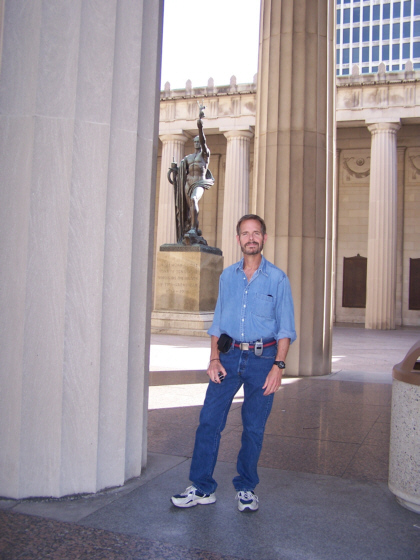 |
The building itself was very well designed and built, with a lot of attention to detail. You can see some of this detail in this picture of the caisson ceiling underneath the plaza-side columns. From that same position underneath the columns, one has an excellent view across the plaza and into downtown Nashville.
Finally, from the steps of the memorial, we could look to our north towards our next stop on this little walking tour- the State Capitol. Before we get there, though, we stopped on the steps leading up to it and looked back at the plaza, and I would like to include the really good picture we got of the War Memorial from that vantage point.
The State Capitol Building (3)
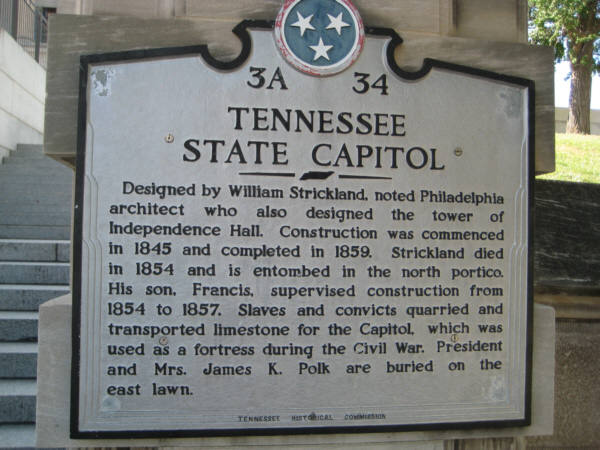 |
"The south is a land that has known sorrows; It is a land that has broken the ashen crust and moistened it with tears; A land scarred and riven by the plowshare of war and billowed with the graves of her dead; But a land of legend, a land of song, a land of hallowed and heroic memories."
"To that land every drop of my blood, ever fibre of my being, every pulsation of my heart, is consecrated forever."
"I was born of her womb; I was nurtured at her breast; and when my last hour shall come, I pray God that I may be pillowed upon her bosom and rocked to sleep with her tender and encircling arms."
From the Carmack statue, one gets an impressive view of the south facade of the Tennessee State House- a beautiful, Greek Revival structure. Walking up to the base of the columnar facade, one can walk all the way around the building. From the south side of the building, we could look back at the entire War Memorial Plaza, the Carmack statue and straight down the street opposite to the Public Library. Take a look at that picture here.
On the east side of the building, one can look down onto the statue of Stonewall Jackson, and from the north side of the structure we could see all of the Bicentennial Park, where our bus tour will take us tomorrow.
Saturday, June 28: Evening Activities
After we finished walking around the War Memorial Plaza and the Tennessee Capitol, we went back by the car that was parked near the Library, and then started walking towards the restaurant that was supposed to be the gathering place for the presenters and attendees from the Festival. Just on the other side of the parking lot, we came out onto 8th Street and started walking towards Broadway. Right there on 8th Street was the Baptist Sunday School Board building, which we both found interesting. It looks almost as if a section of some Greek building, like the Parthenon, was cut out and placed here. The columns seem all out of place for the size of the building. Just down the street towards Broadway, there was a Presbyterian Church office building, and outside a statue of Billy Graham. And looking the other way from the Billy Graham statue, we could see some more of the interesting downtown architecture.
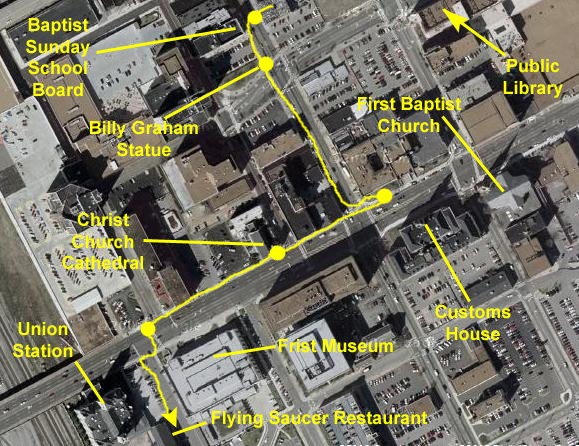 |
Heading back west along Broadway, we passed Christ Church Cathedral. Organized in 1829, Christ Church was Nashville's first Episcopal parish. The present Victorian Gothic church, designed by Francis Hatch Kimball of New York, opened for services on December 16, 1894. The Tower, by local architect Russell E. Hart, was added in 1947.
Below are thumbnails for three more detail pictures of the church. You can see the full-size pictures by clicking on the thumbnails:
 |
 |
 |
The evening gathering was slated to be in a restaurant right next to Union Station, another couple of blocks west on Broadway from Christ Church Cathedral. I don't think that Union Station is used any more- at least not as a railway station. When we got there, someone was holding a wedding reception on what would have been the track platforms. The building itself was very interesting, in a gingerbread, Gothic kind of way. On the south end of the building, there was a tower with flying buttresses near its top, and on the front of the building there was a tall clock tower with a statue of winged Mercury on the top.
We went on in to the Flying Saucer Restaurant to find maybe fifteen people we recognized from the conference, but no one seemed to be having any interesting discussions, so we did not think we would stay long. We did see Whitley Strieber and Anne outside, and we stopped to congratulate them on a successful meeting, when at about that time William Henry joined us to talk to them about their travel plans for the next day. I prevailed on them to let me get a picture with Fred, and I think it turned out really well. You can look at that picture here.
The restaurant there only served sandwiches and beer, so we got a recommendation from William Henry for a Mexican restaurant out west in one of the suburbs, and so we headed out there. After some false turns and a couple of stops to ask directions, we finally found it and had an excellent meal before returning to the hotel.
Sunday, June 29: Our Nashville Tour
On Sunday morning, we got up early and checked out of the hotel to be back downtown in front of the Public Library by 8:15. As part of our Festival attendance, we were all taking a tour of some of the more "mysterious" locations in Nashville, locations tied into William Henry's theories about the "Cities of Light" and stuff like that. There would be two main stops on the tour. The lion's share of our time would be a guided tour of Bicentennial Park, which is downtown just on the north side of the State Capitol. You may remember seeing a picture we took of the park from the steps of the Capitol yesterday. The other stop will be at The Parthenon, which is a bit west out near Vanderbilt University.
I am going to break down today's tour into two subsections- one for the Bicentennial Park and one for the Parthenon. We did so much stuff at the Bicentennial Park, that I will further subdivide that section for each of the stops we made on our walking tour of the park.
We got onto the two buses in front of the Library, and in about fifteen minutes we were parked near the Amphitheatre at the south end of Bicentennial Park.
The Bicentennial Park in Downtown Nashville
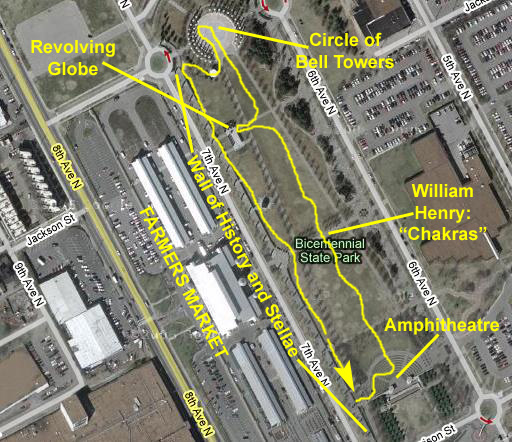 |
He continued this discussion as we walked in a large group north down the center of the park to a stop in the middle. Here, Henry pointed out more about the orientation of the park and its similarities to some diagrams and drawings from as far back as ancient Egypt. He also expounded on his ideas about the way the park represents the "chakras" of the human body.
Next, we stopped at a memorial to Tennessee's contributions in World War II, and saw a unique revolving marble globe.
After that, we spent some time in the circle of bell towers near the north end of the park. William Henry again talked about the layout of the circle, and showed us some really neat aspects of the acoustics in the circle. I stayed in the circle playing with the acoustics while Fred, Henry and about half the group went to the very north edge of the park to take a look at an interesting red marble column.
The last thing we did (other than to have some lunch in the Farmer's Market) was to walk the entire length of the Wall of Tennessee History, and I'll have quite a bit to say about that below.
The Amphitheatre Talks
|
|
As you can see, there were about ninety people here in the amphitheatre, waiting for the program to begin. When I returned to sit next to Fred, he took another picture of some of the folks in the amphitheatre. The morning was overcast but relatively cool and the grass was wet, so everyone sat on the concrete walls. William Henry began his talk about nine, and gave us a lot of interesting information about the park and its layout, and also talked about some of the of the other public buildings nearby in downtown. From where we were sitting, of course, we could see Henry with the State Capitol behind him (although Fred also captured a train going by on the tracks between the park and downtown). When Henry had completed his introductory remarks, we filed out of the amphitheatre to follow him north through the center of the park.
William Henry on Nashville's Origins
|
|
WW II Memorial (Rotating Globe)
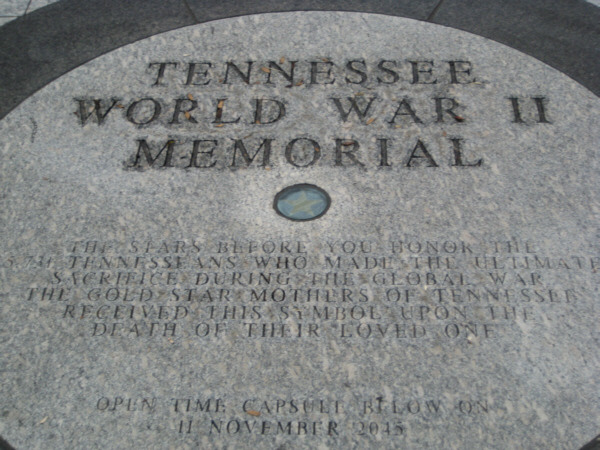 |
This Memorial consisted of three major elements. The first, shown at left, was the commemorative marker for the Memorial itself. The second component was a series of eight commemorative marble slabs, on which were etched major themes or contributions by Tenneseeans to the war effort. The third, and most interesting component was a large, solid black marble globe that was, essentially, floating on a column of water. The pressure of the water coming up from underneath it kept the globe levitated and able to move freely.
On the globe were etched the major battles of the Second World War, and they were connected with lines radiating from Tennessee, lines that were etched with the numbers of Tennessee citizens that participated in those battles or operations. The globe was immensely interesting, and we all crowded around it to get a good look. As it turned out, you could alter the rotation direction and speed by pushing on the globe from one direction or another, as many of us tried to do.
|
|
The Court of Stars
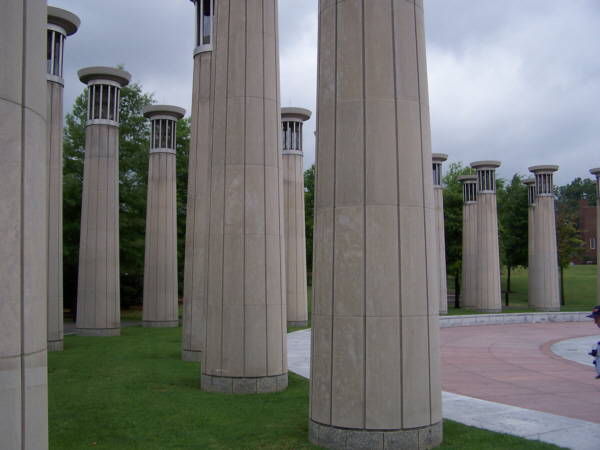 |
Arriving at the Court of Stars, we went on into the area between all the bell towers and gathered around William Henry to hear him describe the towers, their layout, why there are as many as there are, and the connections between the towers and ancient history- just another of the connections he's been making all morning about elements of the structure of the park (and, indeed, of downtown Nashville) to ancient civilizations and prophecies.
The best way for you to get an idea of the kind of information that Henry was imparting is to listen to him, and you can do that by watching a movie I made of part of his talk. Please do so using the movie player below:
|
|
You should also take a look at this pretty good picture of Fred and some of the towers.
Of course, the bell towers also have bells, which, like a clock, chime in music on the quarter hour. I missed the bells the first time they rang, but caught them on the hour as they played "The Tennessee Waltz." (Watch and listen with the movie player below.)
|
|
(What? You were maybe expecting "Dixie?" If so, use the next player to watch and listen!)
|
|
|
|
|
|
The Red Marble Column
|
|
Fred followed Henry and a sizeable portion of the group up to the red marble 1996 Dedication Column, and he listened to Henry's comments on the similarities between the Capitol Mall layout and certain ancient Greek and Egyptian sites. This is one of Henry's recurring themes- that these ancient plans have been duplicated here in Nashville. By whom and for what reason, no one can really say.
The Pathway of History
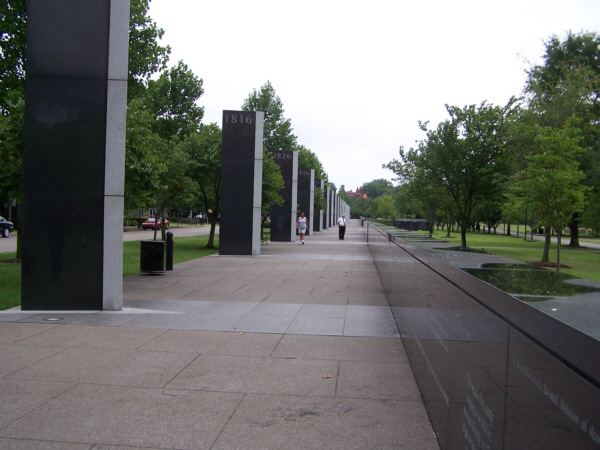 |
Synchronized with these columns, the wall is full of engravings. Some of them are events in Tennessee history while others detail economic or social milestones in that history. Still other engravings are quotations from personages of the time. All of them were interesting, and how the choices were made by whomever made them would be an interesting story in itself.
Another interesting aspect of the Pathway of History was the treatment given to the Civil War Period. The pathway was intended to represent an unbroken continuum of Tenneesee history within the larger history of the United States and, far enough back, of North America. The authors, in that spirit, treated the Civil War as an unfortunate break in that continuum, and so they emphasized this point by breaking the wall into fragments during that period. The wall simply bends somewhat in the 1840s as some Tennesseans begin to advocate alliance with a Confederacy, and the wall symbolically breaks entirely when Tennessee secedes from the Union. The Civil War period is told with more engravings on broken and akilter portions of the wall. At the end of the War, the wall begins to solidify once again and, on the date that Tennessee was readmitted to the Union, the wall becomes straight and unbroken once again.
The whole effect of the wall, from beginning to end is very powerful. I could only wish I had had time to read all the engravings, and perhaps even record the entire wall in pictures. Although, between Fred and myself, we took quite a few pictures, we certainly did not record the entire wall. That's something of a shame, for it would have made quite an entry for this album.
But on thinking about it now, weeks later as I am creating this album page for our Nashville trip, I think it WOULD be nice to at least include the text of all the engravings. So, I searched the Internet until I found a Tennessee government site that linked to a PDF file containing the full text of all the engravings. What I am going to do below is provide you that full text, marked off in the same sections as are marked by the columns along the wall. I will begin at the oldest end of the wall (although the pictures and movies we took were taken as we walked from the most recent history back to that beginning). Whenever we actually took a picture of one or more of the engravings, I will provide you a link to that picture, so you can get a good appreciation for this remarkable display.
I took two good movies while walking along the wall, and, whether or not you choose to examine all the engravings in the section below, you might wish to at least watch these movies.
|
|
I know, however, that you may not wish to spend the time to read all the engravings (or perhaps even read any of them), and so, periodically, I'll provide you a link that will take you directly to the next stop on our Nashville Tour, which was to have a look at a famous sculpture of the Muses over near Music Row. I will also provide periodic links that will allow you to skip ahead along the wall, should you wish to move more quickly to a specific 10-year period. So, before we begin a walk along the Pathway of History, if you would like to skip to the next stop on our tour, please click here.
Engravings on The Pathway of History
In The Beginning
Skip to the
end of the engravings or to
One Billion Years Ago +
|
“And God stepped out on space, and He looked around and said: I’m lonely— I’ll make me a world.” James Weldon Johnson, 1927 |
One Billion Years Ago +
Skip to the
end of the engravings or to
240 Million Years Ago +
| More than a billion years ago, massive forces—shifting rock and sediment and the slow inland encroachment of seas—began to form the land now called Tennessee. | Approximately one billion years ago, Tennessee’s oldest known rocks, found only in the easternmost mountains, formed in a marine or coastal environment. They include the copper deposits of Polk County. | Middle Tennessee was invaded 500 – 570 million years ago by a shallow sea with hard-shelled organisms and primitive plants such as algae, the oldest discovered fossil remains. |
| Tennessee was propelled upward 435 – 500 million years ago, exposing marine sediments. Erosion produced numerous cave systems, sinkholes, and collapse structures that contain some of the world’s most important zinc deposits. The sea invaded again, and at the same time that the Smoky Mountains were being formed. Middle Tennessee was covered in ash from volcanoes in North Carolina and Virginia. | After uplift and erosion 360 – 410 million years ago in the middle and eastern lands, the sea returned to West Tennessee. After two more uplifts, several hundred thousand square miles of mud (later Chattanooga Shale) preserved the first land plants and animals with backbones, including ray fin fish and sharks. | Middle Tennessee was thrust upward again 435 million years ago, and rivers developed on the land surface. |
| The Cumberland Plateau oil and gas deposits originated 330 – 360 million years ago. Crinoids, animals resembling flowers with long stems, lived in large mounds on the sea floor. Later, coal swamps began forming along shorelines. | Shorelines advanced and retreated 290 – 330 million years ago, producing great swamps that were home to fish, reptiles, ferns, cane-like plants, rushes and reeds. | From 240 – 290 million years ago, ancient sediments deposited throughout the eastern United States were pushed into the Appalachian mountain range, with the Cumberland Plateau its western edge. |
|
“Always wrapped in the illusory mists, always touching the evasive clouds, the peaks of the Great Smoky Mountains are like some barren ideal that has bartered for the vague isolations of a higher atmosphere the material values of the warm world below. Upon those mighty and majestic domes no tree strikes root, no hearth is alight, humanity is an alien thing….” Mary Naoilles Murgree, pen name, Charles Egbert Craddock, 1885 |
240 Million Years Ago +
Skip to the
end of the engravings or to the
beginning of the engravings or to
10,000 B.C. +
| The grand land features of Tennessee emerged, and a variety of marine life flourished in the sea covering part of the future fertile earth. As temperatures shifted dramatically, creatures now evidenced y exotic fossils roamed beside new rivers. | Uplift that began 240 million years ago was followed by erosion. This produced distinctive topographical features such as the Valley and Ridge of East Tennessee, Cumberland Plateau, Sequatchie Valley, and Highland Rim. The land surface in Middle Tennessee began dropping below sea level, and a sea ringed by lagoons, swamps, and forests was home to shelled organisms, marine fish, reptiles, and sea turtles. Land plants and trees appeared in West Tennessee. | A sea covered the Coastal Plain of West Tennessee, and perhaps part of the highland Rim, 66 million years ago. Approximately 24 million years later, ancestral streams of the Mississippi, Ohio, Tennessee, and Cumberland Rivers formed. The Central Basin of Middle Tennessee began taking shape, Modern types of plants and animals, such as whales and turtles, abounded. |
|
“The hills sit here like old dethroned kings, met for consultation:
They would be very garrulous, surely, but the exquisite peace of the pastoral scene below them has stilled their life; they have forgotten the ancient anarchy which brought them forth; they dram and dream away, without discussion or endeavor.” Sidney Lanier, 1864 |
Although glaciers did not cover Tennessee, four advances between 1.6 million and 10,000 B.C. gave rise to the Ice Age. Cold alternated with tropical climates. Melting ice flooded lower valleys. Mastodons, saber-toothed cats, great ground sloths, camels, and jaguars roamed dry land. |
“I sing of the mountains that sing in me the cadences of plaintive earth and only give your back the land that framed the valley of my birth…. I sing of the mountains that sing in me Soft harmonies I’ve known from birth. I only give you back the land again And the plain magnificence of earth.” Phyllis Natalie Tickle Margaret Bartlum Ingraham Writing as Natalie Bartlum, 1982 |
| Around 12,000 B.C., the first hunters, seeking a warmer climate during Ice Age, followed large mammals into the state. Vegetation shifted from conifers to modern deciduous forests. |
10,000 B.C. +
Skip to the
end of the engravings or to the
beginning of the engravings or to
1000 B.C. - 900 A.D.
| Around 12,000 B.C., the first hunters, seeking a warmer climate during the Ice Age, followed large mammals into the state. Vegetation shifted from conifers to modem deciduous forests. | Humans, at first migrating in search of food, gradually adapted to their surroundings and developed settled, complex societies. | Archaic-period Indians began settling along rivers and subsisting on game and wild plants around 8000 B.C. |
|
"The world was in its prime, and time rolled on with accustomed regularity. The tiny streams among the hills and mountains shouted with joy, and the broad rivers wound their wonted course along the peaceful valleys. Many a tall oak had grown from the acorn, spread its rich foliage to the summer winds, decayed with age, and mingled with its mother earth." Choctaw tradition, recorded by Charles Lanman, 1856 |
Cultivation of edible plants began 3000‑900 B.C. |
1000 B.C. - 900 A.D.
Skip to the
end of the engravings or to the
beginning of the engravings or to
1600 A.D.
| The Woodland Indian culture, characterized by settled communities, pottery production, and burial mounds, existed about 1000 B.C.-A.D. 900. | By A.D. 1250, prehistoric habitation peaked during the Mississippian era with a complex society, large towns, far-ranging trade routes, elaborate pottery and personal items, and ceremonial mounds. |
"A considerable portion of the city of Nashville has been built over an extensive Indian graveyard which lay along the valley of Lick Branch.... All around the sulphur spring [here], traces of the aborigines are manifest...." Joseph Jones, M.D., 1876 |
| The Mississippian culture disappeared in Middle Tennessee about 1450, but remained alive in East Tennessee until the early 1600s. | Contact between Native Americans and Europeans began in 1540-1541 with Hernando de Soto's search for gold and silver that extended into East Tennessee and to the Mississippi River. Juan Pardo led a similar expedition, 1566-1567. |
"Still majestic in decay stand the great temple mounds. The temples that once crowned their heights, like the hands that built them, have long since crumbled to dust. And their contours, blurred by the centuries' winds and rains, erode a little more each day." Thomas M. N. Lewis Madeline Kneberg, 1958 |
| In 1584, England's Queen Elizabeth granted Sir Walter Raleigh a patent to lands including the future Tennessee. |
1600 A.D.
Skip to the
end of the engravings or to the
beginning of the engravings or to
1766
| Three major Native-American nations were living in future Tennessee when early French and English explorers and their African slaves arrived. Both cooperation and struggle were commonplace among these diverse peoples. | From the 1500s, diseases to which Native Americans had no natural immunity were brought from Europe by explorers and settlers, resulting in depopulation. In 1738-1739, nearly half of the Cherokee died from smallpox. | On July 15, 1673, James Needham and Gabriel Arthur, first English-speaking men to cross the Appalachian Mountains into the future Tennessee, arrived at the Overhill Cherokee village of Chota. |
|
"They were, however, as much frightened as ourselves, and what we took for a signal of war was an invitation to come near that they might give us food." Father Marquette, camped on the Chickasaw Bluffs, 1673 |
Fort Prud'homme was built in 1682 by French explorer Robert Cavelier, Sieur de la Salle, on the first Chickasaw Bluff, near the mouth of the Hatchie River. |
"When civilization first peeped over the Alleghenies and looked down on the gorgeous landscape below, I think she shouted back to the advancing hosts, 'Lo, this is Paradise regained" Governor Robert Love Taylor, 1897 |
| In the early 1700s, the Cherokee forced the Creek and Yuchi from East Tennessee and with the Chickasaw drove the Shawnee out of Middle Tennessee. | In 1710, Frenchman Charles Charleville established a trading post called French Lick, the future Nashville. | Dr. Thomas Walker explored and named the Cumberland Gap mountain passage in 1750. |
| In 1748, Overhill Cherokee supplied most of the 160,000 animal pelts exported to Europe from South Carolina. | Beginning in 1754, England and France struggled over American lands, including Tennessee, in the French and Indian War. | In 1757, the British completed Fort Loudoun in East Tennessee to maintain Cherokee loyalty in the French and Indian War. |
| In 1760, the Cherokee seized Fort Loudoun and killed nearly two-dozen inhabitants in equal retaliation for the execution of chiefs by the British. In return the next year, the British destroyed 15 Cherokee towns and burned 1,500 acres of crops, resulting in hundreds of Cherokee deaths over time. |
In 1760, Daniel Boone explored much of East Tennessee, traversing the valleys of the Holston and Watauga Rivers.
The English and the Cherokee made peace in 1761. |
People called long hunters, because they entered the wilderness to hunt, trap, and trade for months or years, began to pave the way for permanent settlements. Elisha Walden, for whom Walden's Ridge is named, set out in 1761 from Virginia with a group of long hunters to explore East Tennessee and the Cumberland Valley. |
| The French and Indian War ended in 1763, with France surrendering all claims to lands east of the Mississippi River. England established the Proclamation Line forbidding pioneer settlement west of the Appalachian Mountains. |
1766
Skip to the
end of the engravings or to the
beginning of the engravings or to
1776
|
"The Great Being above is very good, and provides for everybody. It is he that made fire, bread, and the rivers to run. He gave us this land, but the white people seem to want to drive us from it." Cherokee Chief Attakullalulla, "The Little Carpenter," 1769 |
The wilderness gave way as pioneer settlements spread slowly westward. Efforts at self-government foreshadowed the American revolution, and the stage was set for dire struggles over land. | The Treaty of Hard Labour, signed by the Cherokee and the British in 1768 to prevent pioneer settlement in Tennessee, failed to stop an inrush of Virginians and Carolinians toward Cherokee land. |
|
William Bean, believed to be the first permanent European settler in Tennessee, built a cabin in 1769 on Boone's Creek, near its junction with the Watauga River.
French-Canadian fur trader Jacques-Timothe' Demonbreun visited the Nashville area as early as 1769 and settled here in 1790. |
".. . some stopped in the mountains. A horse died, a cart broke down, a young couple could not leave the grave of their only child; fatigue, illness, the lure of the mountains—now it was one thing and another; but when the host had passed, there were scattered dwellings being reared among the great hills, and a few hundreds—progenitors of many thousands—had begun a course of life which was to continue unchanged for generations." Bishop Burelson, quoted in 1927 |
Pioneer settlements were established in East Tennessee during the early 1770s on Cherokee lands leased near the Watauga River, north of the Nolichucky River. The settlements of Carter's Valley and North of the Holston River were also established during this period. |
| In 1771, after John Donelson's survey, the Wataugans were advised that they were in North Carolina, not Virginia, and were illegally residing on Indian land. | In the early 1770s, parties of long hunters led by James Smith and Isaac Bledsoe extensively explored Middle Tennessee. Long hunter Kasper Mansker visited the Cumberland settlements in 1770, and in 1780, he built the fort named for him in present-day Goodlettsville. |
"Now's the time to keep the country. If we give up now it will ever be the same." Daniel Boone's advice to the Wataugan community, about 1772-73 |
| In 1772, the Watauga Association document was created, bringing the first written form of government in present-day Tennessee. |
“...a Set of People in the back part of this Colony bordering on the Cherokee Country...have appointed Magistrates and framed laws...and...erected themselves into...a Separate State...[which] Sets a dangerous example to the people of America of forming Governments Distinct from and independent of His Majesty's Authority.” Lord Dunmore, Royal Governor of Virginia, May 1774 |
At Sycamore Shoals in 1775, Richard Henderson negotiated the Transylvania Purchase of more than 20 million acres in future Tennessee and Kentucky from some, but not all, of the Cherokee leaders. Much of this land was also claimed by Chickasaw, Shawnee, and other tribes. |
|
"You have bought a fair land, but you will find its settlement dark and bloody"
Dragging Canoe, leader of the Chickamauga, Sycamore Shoals, 1775 |
Sinking Creek Baptist Church, the state's oldest church still in existence, was organized 1774-1775 between Johnson City and Elizabethton. |
1776
Skip to the
end of the engravings or to the
beginning of the engravings or to the
previous decade or to the
next decade
| Daniel Boone oversaw 30 axmen clearing Boone's Trace, and led settlers through northeast Tennessee and the Cumberland Gap into Kentucky in 1775. | Against the backdrop of the American Revolution, settlement was begun in Middle Tennessee and continued in East Tennessee, often in a hostile atmosphere of attacks and reprisals by both pioneers and Indians. | As British allies, Cherokee attacked East Tennessee settlements in 1776; soldiers responded by attacking Cherokee towns. |
| In 1779, James Robertson's overland party arrived from East Tennessee at French Lick (near here). They were joined the next year by John Donelson's party, arriving by boat after navagating the Holston, Tennessee, Ohio, and Cumberland Rivers. | In 1776, Nanye'hi (Nancy Ward), "Beloved Woman" of the Cherokee, exercised her responsibility as a defender of peace by warning settlers of impending Cherokee attack. The Cherokee nation split and its war-seekers became the Chickamauga band near Chattanooga. | Jonesborough, the first pioneer town in Tennessee, established in 1779. |
|
African Americans were with the earliest explorers and settlers of Tennessee. By the time of the census of 1790, they numbered about ten percent of the population.
In 1780, at the Revolutionary War Battle of Kings Mountain in South Carolina, Tennesseans helped defeat the British under the command of Patrick Ferguson. |
"Monday, April 24th: This day we arrived at our journey's end at the Big Salt Lick, where we had the pleasure of finding Capt. Robertson and his company. It is a source of satisfaction to us to be enabled to restore to him and others their families and friends, who were entrusted to our care, and who sometime since, perhaps despaired of ever meeting again. Though our prospects are dreary, we have found a few log cabins which have been built on a cedar bluff above the lick by Capt. Robertson and his company." John Donelson's diary, 1780 |
"Twas on a pleasant mountain The Tory heathens lay, With a doughty major at their head, One Ferguson, they say. Cornwallis had detach'd him A-thieving for to go, And catch the Carolina men, Or bring the rebels low." "The Battle of King's Mountain" Anonymous |
|
The Reverend Samuel Doak introduced formal education in the future state with the founding of Martin Academy in 1780 near Jones borough.
'Truth is, if we had no land, -we should have fewer enemies." |
"Every one must decide for themselves ... my mind is made up; I have never thought of leaving. When we came, the whole
country was in possession only of the buffalo, bear, deer, and all wild animals; there were no Indians living within hundreds of miles of our settlements.... Here is the extensive country; we shall find no better." James Robertson, 1780 as recorded by John Haywood |
The separate State of Franklin, with John Sevier as governor, was formed in 1784 around Greeneville by future Tennesseans dissatisfied with North Carolina's lack of protection.
Captain James White settled in 1786 on the site of the future Knoxville. |
1786
Skip to the
end of the engravings or to the
beginning of the engravings or to the
previous decade or to the
next decade
| Mero District established by North Carolina in central part of the future state in November 1788. | "Avery's Trace," also known as the North Carolina Road, from Campbell’s Station west of Knoxville to the Cumberland settlements, facilitated east-west travel by 1788. | First iron works established in Hawkins County on the Holston River about 1789-1790. James Robertson's Cumberland Furnace iron works established in Dickson County about 1793. |
| After four years of occasional armed struggle, the State of Franklin ceased to exist in 1788. | Frontier settlements became more permanent, despite Cherokee resistance which lasted until 1795. In a momentous decade, North Carolina citizenship gave way to territorial status in preparation for Tennessee statehood under the new nation. | North Carolina ceded its western lands to the national government in 1789, and present-day Tennessee existed as the Southwest Territory from 1790 to 1796. William Blount was appointed territorial governor. |
|
"Be it enacted by the Senate and the house of Representatives of the United States of America, in congress assembled, that the territory of the United States, south of the river Ohio, for the purposes of temporary government, shall be one district; the inhabitants of which shall enjoy all the privileges, benefits, and advantages..." Congressional act creating the Southwest Territory, 1790 |
Rocky Mount became the first territorial capital in 1790 when Governor Blount established temporary residence at the home of William Cobb.
Tennessee's first newspaper, The Knoxville Gazette, published in 1791 at Rogersville. |
In 1791, John Hague built the third cotton textile mill in Use U.S. near Nashville. It was abandoned after Indian raids in 1793.
Knoxville, laid out in 1791 by Charles McClung, became, the territorial capital when Governor Blount moved there in 1792. |
| At age 25, Andrew Jackson received his first military appointment, judge advocate for the Davidson County militia. | General Daniel Smith made first map of Tennessee in 1794. | Warfare between the Cherokee and settlers intensified during 1792-1794. |
| In 1794, Blount College, forerunner of the University of Tennessee, Chartered at Knoxville. | In the 1790s, land speculators purchased hundreds of thousands of acres in East and Middle Tennessee. | In 1794, an elected Territorial Assembly held its first session. |
| Greeneville (later Tusculum) College chartered in 1794. | In 1795, a census revealed that the territory exceeded the required 60,000 population to petition Congress for Tennessee statehood. | Defeat of Chickamaugas, Creeks, and Shawnees diminished Indian warfare by 1794. |
1796
Skip to the
end of the engravings or to the
beginning of the engravings or to the
previous decade or to the
next decade
| Statehood on June 1, 1796, gave Tennesseans their own government and renewed confidence in their destiny. The Cherokee and Chickasaw still claimed three-fourths of the state's territory, but this changed dramatically within one generation, as new treaties and new roads brought more and more people into East and Middle Tennessee. | In 1796, Tennessee's first General Assembly met in Knoxville, adopted a constitution, selected John Sevier governor, William Blount and William Cocke U.S. Senators, and Andrew Jackson U.S. Representative. | Wilderness Road completed in 1796. |
|
"I have the pleasure of announcing to you, gentlemen, the admission of the State of Tennessee into the Federal Union, a circumstance pregnant with every flattering prospect of peace, happiness and opulence to our infant State. The period is at length arrived when the people of the South Western Territory may enjoy all the blessings and liberties of a free and Independent republic." John Sevier, Tennessee's first governor, 1796 |
The Knoxville Gazette favored abolition of slavery in 1797.
In 1797, first fair in the state held at Greeneville.
Spanish garrison San Fernando de Barrancas, built in 1795 on the Lower Chickasaw/ Bluff at present-day Memphis, dismantled in 1797. |
The state's first camp meeting was held in Sumner County in 1799; religious revivalism swept the state in 1800.
1800 Population: 105,602.
In 1801, with permission of the Chickasaw and Choctaw, federal troops widened the Natchez Trace. |
| Walton Road, the state's first toll road, connecting Kingston and Nashville and operated by the Cumberland Turnpike Company, was completed in 1802. |
Treaties negotiated 1798-1807 with the Cherokee and Chickasaw ceded south-central and Cumberland Plateau lands for pioneer settlement.
Eighty percent of population farmed the land and raised livestock. |
"Whether it proceeds from the goodness of the water, the purity of the air, the temperature of the climate or whatever
else may have been the cause, the inhabitants of that country have certainly been remarkably healthy ever since they
settled on the water of [the] Cumberland river." Gilbert Imlay, 1797 |
1806
Skip to the
end of the engravings or to the
beginning of the engravings or to the
previous decade or to the
next decade
| A settled atmosphere encouraged an increasing pace of immigration, and farming was the occupation of choice. | Andrew Jackson gained national prominence in the War of 1812. | In West Tennessee, the earth asserted its restlessness with powerful quakes. |
| Bank of Nashville, first in the state, chartered in 1807. | To fulfill the letter but not the spirit of a treaty, the General Assembly designated Kingston the state capital for one day in 1807 to obtain land from the Cherokee. | Commonly grown crops included corn, wheat, rye, oats, and barley, with tobacco and cotton raised for market. |
|
In 1809, Meriwether Lewis, who had explored the Northwest with William Clark, died on the Natchez Trace near present-day Hohenwald.
1810 Population: 261,727 |
"...the roads were congested with movers during the summer months- great top-heavy Conestoga wagons drawn by oxen, befrilled gentlemen astride blooded horses, rawboned farmers on hairy plow-nags, peddlers and merchants with their trains of meager donkees, immigrants too poor to afford meager belongings and children on their backs-all moving west toward the promised land in Tennessee." Anonymous, early 19th century |
Earthquakes along the still-active New Madrid seismic zone formed Reelfoot Lake in 1811-1812.
"At daylight we had counted 27 shocks... The [Mississippi] river was covered with foam and drift timber, and had risen considerably... there was another violent shock... The trees on both sides of the river were most violently agitated and the banks in several places fell in within our view, carrying with them innumerable trees, the rush of which falling in the river, mixed with the terrible sound attending the shock and the screaming of the geese and other wildfowl, produced an idea that all nature was in a state of dissolution..." |
| Bank of the State of Tennessee established in 1811 at Knoxville with branches in four cities. | First public library in state opened at Nashville in 1813. | In Roane County during 1814, coal was mined for the first time in Tennessee. |
| Following the Battle of Horseshoe Bend in 1814, where Andrew Jackson defeated the Creeks with critical aid from the Cherokee, he was proclaimed a national hero. This War of 1812 battle in Alabama was one of the largest between Native Americans and the United States Army. Here Tennesseans first received national recognition for their volunteer spirit. |
Tennessee Society for Promoting the Manumission of Slaves organized in Jefferson County in 1814.
Tennessee "Volunteers" showed marked valor as Andrew Jackson defeated the British at the Battle of New Orleans in 1815.
Andrew Jackson appointed a U.S. Commissioner in 1816 to negotiate Cherokee and Chickasaw land cessions. |
"Slavery is...a volcano in disguise, and dangerous to the safety and happiness of any government on earth when it is tolerated." Thomas Roan to the Tennessee Manumission Society, 1820 |
1816
Skip to the
end of the engravings or to the
beginning of the engravings or to the
previous decade or to the
next decade
| A major treaty with the Chickasaw in 1818 opened West Tennessee to restless settlers, and land speculators took advantage of inherent opportunities. Local governments and other cultural institutions developed in burgeoning towns, as steamboats connected Tennessee to far-flung markets. | John Overton, with Andrew Jackson and James Winchester, platted Memphis on land they owned. | The Jackson Purchase of 1818 from the Chickasaw encouraged settler migration into West Tennessee. The Chickasaw expected by treaty to continue residence, but were removed in the 1830s. |
| In 1817 or 1818, Ralph E.W. Earl's collection of relics was on display at his Nashville museum. Earl's artifacts were eventually incorporated into collections of the Tennessee Historical Society and later the Tennessee State Museum. | In 1819, the General Jackson was the first steamboat to arrive at Nashville, and it departed with a cargo of tobacco. | In 1819, The Manumission Intelligencer, first anti-slavery paper in the United States, published at Jonesborough. |
|
Maryville College founded in 1819.
Tennessee Antiquarian Society, a progenitor of the Tennessee Historical Society, founded in 1820 with John Haywood as president.
By the 1820s, the Cherokee existed only in the state’s southeastern corner and in northern Georgia. |
"Buried, as it were, in the wilderness, beyond the outskirts of busy civilized life, we lived in Quaker simplicity. The schoolmaster and the preacher had not yet arrived... Peer of the noblest of the land, we were a law unto ourselves, drawing philosophy from the shades of the wild woods and the profusion of wild/lowers that decked the bosom of mother earth..." Joseph S. Williams, 1873, describing his family's homestead in the Hatchie country, about 1820 |
1820 Population: 422,823.
“I did believe, and ever will believe, that just laws can make no distinction a/privilege between the rich and poor, and that when men of high standing attempt to trample upon the rights of the weak, they are the fittest objects for example and punishment. In general, the great can protect them-selves, but the poor and humble require the arm and shield of the law." |
| Sequoyah completed his syllabary, a written language, for the Cherokee Nation in 1821. The Cherokee moved very rapidly to literacy, thereby giving then" nation the power of "the talking leaves." | In 1823, Jackson Male Academy (later absorbed by schools that became Union University) founded at Jackson. | The Pioneer, first newspaper in West Tennessee, published at Jackson in 1823. |
| Public schools were first established by law in 1823, but were inadequately funded until the direct taxation school support legislation in 1854. The Civil War interrupted this growth. | Music publishing began at Nashville in 1824. | Nashoba, Utopian colony for freed slaves, established by Frances Wright in 1825 near Memphis. |
1826
Skip to the
end of the engravings or to the
beginning of the engravings or to the
previous decade or to the
next decade
|
David Crockett elected in 1827 to U.S. Congress. "I leave this rule for others when I am dead: Be always sure you're right—then go ahead." David Crockett, 1834 |
With Tennessee's transition from frontier's edge to national prominence, its homegrown heroes— Jackson, Crockett, Houston, and Polk— moved into important positions of state and national leadership. Andrew Jackson's two presidential elections reflected a "rise of the common man." | Sam Houston, who as a young man lived among the Cherokee, was elected governor in 1827. |
| First Memphis newspaper, Memphis Advocate, appeared January 18, 1827. | The Atlas reached Knoxville in 1828, becoming the first steamboat to navigate the entire Tennessee River. | Andrew Jackson elected U.S. President in 1828. |
|
"President [Andrew Jackson] is of the opinion that the only mode left for the Indians to escape the effects of such enactments [by the states], and consequences more destructive...is, for them to emigrate... He is sincerely anxious... to save these people..." John Eaton, Secretary of War, 1829 |
“I am told that the Government of the United States will spoil their treaties with us and sink our National council under their feet. It may be so, but it shall not be with our consent, or by the misconduct of our people...if they act the tyrant and kill us for our lands, we shall, in a state of unoffending innocence, sleep with thousands of our departed people." Cherokee Chief Womankiller, 1829 |
In 1830, Medical Society of Tennessee established.
1830 Population: 681,904.
Gold discovered in 1831 at Coker Creek. |
| State penitentiary opened in 1831. | First railroad company, Franklin Railroad, chartered in 1831. | In 1832, Andrew Jackson re-elected President. |
| Asiatic cholera epidemic swept the state in 1833. | Oldest still-standing courthouse built in 1833 at Charlotte in Dickson County. | A new constitution in 1834 provided for fairer taxation and more opportunities for representation, but continued to deny suffrage for women and took away free African-American male voting rights. |
|
"...knowledge, learning, and virtue, being essential to the preservation of republican institutions...it shall be the duty of the General Assembly in all future periods to cherish literature and science." Tennessee Constitutions of 1834 & 1870 |
Signed by about 300, but later disavowed by the great majority of the Cherokee, the Treaty of New Echota in 1835 provided for their removal to the Trans-Mississippi West. | In 1835, the Cherokee owned prosperous farms, thousands of livestock, many sawmills, blacksmith shops, and cotton gins. They also had numerous slaves. |
| James K. Polk from Columbia elected Speaker of the U.S. House of Representatives in 1835. |
1836
Skip to the
end of the engravings or to the
beginning of the engravings or to the
previous decade or to the
next decade
|
David Crockett killed at the Alamo in 1836.
Sam Houston led Texas in 1836 to independence from Mexico and became president of the new Republic of Texas. |
"Here is the secret. Full license to our oppressors, and every avenue of justice closed to us. Yes, this is the bitter cup
prepared/or us by a republican and religious government— we shall drink it to the very dregs." Elias Boudinot in the tribal newspaper, Cherokee Phoenix, 1830 |
Tennessee became a leading agricultural state, Nashville was selected as the permanent capital, and the establishment of new schools and colleges reflected a growing, refinement. |
| Thousands of Cherokee were forcibly removed from their ancestral Lands east of the Mississippi River to Oklahoma territory. | In 1836, President Andrew Jackson declared the Treaty of New Echota binding, thereby mandating Cherokee emigrate by 1838 or be removed. | Uniform system of public schools established in 1837. |
| Formerly named Ross's Landing for Cherokee Chief John Ross, Chattanooga was established in 1838. |
"When a people has their head in the Lions mouth, prudence requires them to take it out with great care. We are all laboring in great suspense to hear our final doom." Cherokee Chief John Ross before removal, 1838 |
In 1838, over 4,000 of the more than 17,000 removed Cherokee died on the Trail of Tears. |
| With Indian claims effectively ended, the current Tennessee boundaries were resolved. | 1840 Population: 829,210 | Tennessee became one of the three largest tobacco-producing states. Wessyngton in Robertson County was the largest U.S. tobacco plantation. |
| With a varied farm economy, Tennessee was the nation’s largest corn producer in 1840. | Cumberland University founded in 1842 at Lebanon. | First train exhibition run made in 1842 on the LaGrange and Memphis Railroad. |
| Bethel College established in 1842 at McKenzie. | After intervals in Knoxville, Murfreesboro, and Kingston, Nashville became the permanent state capital in 1843. | In 1844, James K. Polk was elected U.S. President. During his term of office, territorial gains from the Mexican War extended the western border of the United States to the Pacific Ocean. |
| Supervised by architect William Strickland, construction of the state capitol began in 1845. | Lambuth College founded at Jackson in 1843 as Memphis Conference Female Institute. |
1846
Skip to the
end of the engravings or to the
beginning of the engravings or to the
previous decade or to the
next decade
|
Humanitarian concerns for the welfare of mentally ill persons, criminals, and school children emerged in the 1840s.
State’s first wire transmission company chartered in 1847. the New Orleans and Ohio Telegraph Company. |
“I represent the existence of troubles no imagination can exaggerate, and I have come to Tennessee as the advocate and friend of those who can not plead their own cause, and for those who have no friend to protect them... Tennessee has been called ‘the Mother of States;’ Shall she not, by the promulgation of wise laws, the liberal encouragement of schools of learning, and the substantial support of beneficient institutions, offer an example for the young States she has so largely and widely colonized?” Dorothea L. Dix to the General Assembly for a new hospital for the “insane,” 1847 |
In 1848, “Volunteer” nickname became popular as a result ot the more than 30,000 men who responded to a Mexican War troop call for 2,800.
Copper discovered in 1849 in Ducktown Basin in the southeastern corner of the state. |
| James K. Polk, 11th President of the United States, died in Nashville in 1849. | The Nashville Convention of 1850 discussed secession of the Southern states, foreshadowing divisions that would violently erupt with the onset of the Civil War. | Women on antebellum farms and plantations were responsible for the religious, educational, medical, food, and clothing needs of both slaves and free people. |
| In 1850, Fayette, Haywood, Madison, Shelby, and Hardeman counties produced 120,811 bales of cotton, approximately 70% of the state’s crop. | Memphis was the fastest growing town in the nation in the 1850s. | State population in 1850: 1,002,717. |
| The Adelphi Theatre, with the second largest stage in the country, opened in 1850 in Nashville. | Nashville physicians established a medical college in 1850 at the university of Nashville. | Tennessee gained increasing prosperity and an expanding sphere of agricultural and manufacturing influences, as well as more sophisticated cultural pursuits. |
| Jenny Lind, “the Swedish Nightingale.” Performed in Nashville and Memphis in 1851. | State Library established in 1853. | The first General Assembly to meet in the new Capitol was convened by Governor Andrew Johnson in 1853. |
| First tax for public education was instituted in 1854. | Reflecting the economic dominance of farming, county agriculture societies were organized in 1854. | By the 1850s Nashville was an established publishing and printing center. |
| The Nashville and Chattanooga Railroad began in 1854. | The first biennial State Fair, forerunner of the present annual State Fair, held in Nashville in 1855. | With virtually no operational tracks in 1849, by 1860 Tennessee had 1,253 miles of working railroad. |
1856
Skip to the
end of the engravings or to the
beginning of the engravings or to the
previous decade or to the
next decade
| Mining one of the world’s most important zinc deposit began in Jefferson County in 1856. | Connecting the two cities, the Louisville and Nashville Railroad began operation in 1859. | Tennessee, previously home of a peaceful emancipation movement, grew increasingly divided over the issues of slavery and states’ rights. The Civil War years were filled with deprivation, difficulty, distrust, disease, and death. |
| From 1810 to 1860, the number of slaves in Tennessee increased from 44,734 to 275,719, and the number of free blacks grew from 1,318 to 7,300. | Less than 5% of the state’s white population were slave holders in 1860. Most of these owned 1 or 2 slaves, alongside whom they worked. | State Population in 1860: 1,109,801 |
| Governor Isham Harris issued a proclamation dissolving all connection with the Federal Union on June 24, 1861, and Tennessee, the last state to join the Confederacy, entered the Civil War which began on April 12. | Memphis’ LeMoyne Institute originated in 1862. | Knoxville and Greeneville hosted conventions in 1861 to discuss East Tennesee’s possible re-entry to the Union. |
|
“Tennessee will not furnish a single man for the purposes of coercion, but 50,000 if necessary, for the defense of our southern brethren.” Gov. Isham G. Harris Responding to Lincoln’s call for troops to suppress The Confederacy, April 1861 |
In February, 1862, Fort Henry and Donnelson fell to Federal troops under General Ulysses Grant, opening Nashville and most of Tennessee to Union occupation. | Federal troops occupied Nashville on February 24, 1862, and made it union headquarters, supply depot, and hospital center. |
| In 1862, Union soldiers brought baseball to Nashville, and they played here in the area of the Mall. |
“Hospital Duties” Fold away all your bright – tinted dresses, Turn the key on your jewels today, And the wealth of your tendril–like tresses Braid back in a serious way; No more delicate gloves, no more laces, No more trifling in boudoir or bower, But come with your souls in your faces To meet the stern wants of the hour. Anonymous |
The battle of Shiloh, which took place April 6 – 7, 1862, had 25,000 casualties.
“Gentle winds of springtime seem a sighing over a thousand new-made graves.” |
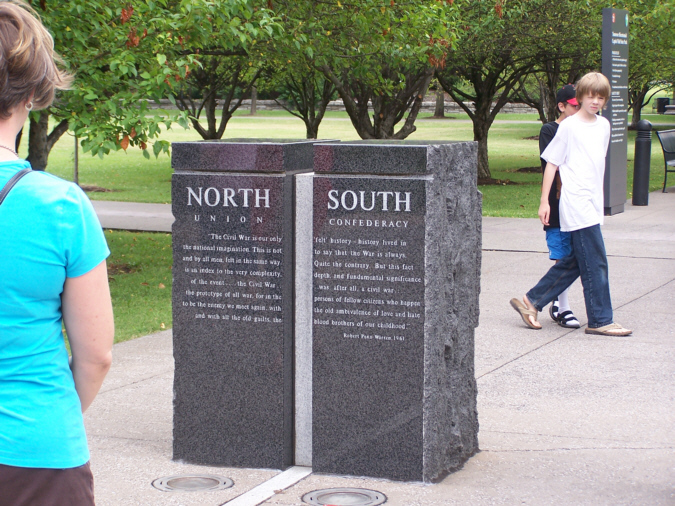
At this point in the history, the fracturing and splintering of the wall is at its maximum. In the center of this fractured area of disarray, two plain stone tablets record this as the turning point in the history of Tennessee and its relationship to the Union. Regardless of which way you walk, as you face these tablets, the history to your left (into the future) has the wall slowly regaining its structure as, predictably, the Civil War is drawing to a conclusion that will reestablish the Union and, eventually, re-admit Tennessee. To your right (into the past) we find the mirror image occurring as we regress through history to an earlier point where Tennessee had not yet cast its lot with the Confederacy.
Fittingly, these two tablets are titled "NORTH" and "Union" on the left (future) and "SOUTH" and "Confederacy" on the right (past). Spread across the two columns, half on one and half on the other, is a quotation that expresses, for this Pathway of History, the realization that Tennessee, and indeed the entire South, is better off as part of the Union than by itself, although it took three more years of war to make that point clear to everyone.
Here is the quotation that is spread across these two columns:
“The Civil War is our only ‘felt’ history– history lived in the national imagination. This is not to say that the War is always, and by all men, felt in the same way. Quite the contrary. But this fact in an index to the very complexity, depth, and fundamental significance to the event. The Civil War...was, after all, a civil war. The prototype of all war, for in the persons of fellow citizens who happen to be the enemy we meet again, with the old ambivalence of love and hate and with all the old guilts, the blood brothers of our childhood.”
| Robert Penn Warren, 1961 |
| Memphis surrendered to Union forces June 6, 1862. |
"I have seen so much of prejudice, and its dirty work, that I have absolutely come to the conclusion that it is wicked in the first degree; that it is a wicked outrage upon the human family.” Anonymous |
Battle of Stones River December 31. 1862 and January 2, 1863. One in four who fought were casualties. |
|
"Then the earth throbs with the roll of drums and the measured tread of martial hosts." Mary Noailles Murfree in the Stones River battlefield, 1884 |
Bloody checkmate at the battle of Chickamauga on September 19 – 20 1963
“...the dead were piled upon each other...like cord wood.” |
Battle of Knoxville, November, 1863. |
| Battles of Chattanooga, Lookout Mountain, and Missionary Ridge, on November 23 – 25, 1863, secured the Union stronghold in Tennessee. |
“Our animals were starving, and the men had starvation before them.” Northern soldier at Chattanooga |
With the re-election of President Lincoln in 1864, Tennessee’s governor Andrew Johnson, was elected Vice-President on November 4. |
|
Battle of Franklin, November 30, 1864.
“Boys, this will be short but desperate.” Strahl made that remark to his men as they prepared to charge the open field. Strahl was one of five Confederate generals killed that day among 6,000 Confederate casualties. |
Battle of Nashville, December 15 – 16, 1864, ended the last desperate Confederate attempt to regain Tennessee. |
“The blood of white and black men has flowed freely together...” Union General George Thomas Thomas made the comment after the Battle of Nashville in which the US Army included a significant number of African-American soldiers. |
|
Lincoln assassinated! Andrew Johnson assumed the Presidency the next day, April 15, 1865. |
“You have been good soldiers; you can be good citizens. Obey the laws, preserve your honor, and the government...will be magnanimous." Confederate General N.B. Forrest to his troops upon their surrender, May, 1865 |
Slaves freed by Tennessee constitutional amendment in 1865. |
| The Army of Tennessee, the last major Confederate force, surrendered on April 26, 1865, as the Civil War ended. | Klu Klux Klan formed in Pulaski on December 24, 1865. |
1866
Skip to the
end of the engravings or to the
beginning of the engravings or to the
previous decade or to the
next decade
|
|
|
Furl that banner! For ‘tis weary, Round its staff ‘tis drooping dreary; Furl it, fold it, it is best: For there’s not a man to wave it, And there’s not a sword to save it, And there’s not one left to lave it In the blood which heroes gave it, And its foes now scorn and brave it, Furl it, hide it, let it rest. Chorus of “The Conquered Banner” Father Abram J. Ryan, 1865 |
Fisk University opened on January 9, 1866.
“Do not expect us to do all, nor half, but put your shoulders to the wheel and do it for yourselves.” |
On July 24, 1866 Tennessee was the first state to be restored to the Union after ratifying the 14th amendment which extended citizenship to black freedmen. |
| Federal Army departed Tennessee in 1866. | Separate Negro schools established in 1867 at state expense. | Due in part to pressure applied by the National and State Colored Men’s Conventions, Tennessee’s Brownlow administration granted suffrage for black men in 1867- two years before Congress did. |
| Ex-Confederates regained the vote in 1869. | State Population in 1870: 1,258,520. | The original Ku Klux Klan was effectively disbanded in March, 1869. |
| Third State Constitution adopted in 1870. | The Constitutional Convention forged a document that aided unifying sentiments by abolishing slavery and preserving the rights of African-Americans to vote. A tax in voting, however, prohibited many whites and African-Americans from casting ballots. | Tennessee began to recover slowly from the Civil War that had interrupted its arc of material and social progress. During the Reconstruction era African-Americans made overt political gains which would be eroded by the turn of the century. The first African-American elected official in the state was Randall Brown, a Davidson County Commissioner in 1870. |
| Vanderbilt University established in 1873. | In 1872, Sampson Keeble of Nashville was the first of 13 African-American legislators elected to the Tennessee House of Representatives in the 19th century. | Fisk Jubilee Singers toured Europe in 1873 to raise money for the purchase of a new and larger campus and to build Jubilee Hall. |
| First State Board of Education established in 1875. | In 1873, approximately 2,000 people died in Memphis during a Yellow Fever epidemic. | Knoxville College opened in 1875. |
| In 1873, eleven blast furnaces on the Western Highland Rim produced iron at the rate of about 50,000 tons per year. To operate indefinitely, these furnaces would have required 375 square miles of timber for fuel. |
1876
Skip to the
end of the engravings or to the
beginning of the engravings or to the
previous decade or to the
next decade
| Aided by infusion of northern capital, Tennesseans worked hard to recapture economic and cultural momentum lost during the war. African Americans continued gaining ground in the postwar period. | Yellow fever epidemics pointed to the need for stronger civic concerns such as city sewers and sanitation engineering. | The first independent Republican African-American gubernatorial candidate, William F. Yardley of Knoxville, captured 1% of the statewide vote in 1876. |
| By the 1870s, the Jewish population supported synagogues in Brownsville, Memphis, Nashville, and Chattanooga. |
“When you are an old man, I want you to remember that your old teacher said, 'Don’t ever be a spectator; take a hand in the game!'” William R. "Sawney" Webb, founder of Webb School, Bell Buckle |
Meharry Medical College for Negroes founded in 1876. |
|
State Board of Health created in 1877.
In 1878, the yellow fever epidemic in Memphis so decimated the population that the legislature revoked the city charter and directly oversaw the metropolis for 14 years. |
"...there was much agitation over the question of [yellow fever] quarantine. In addition to being bankrupt, Memphis had suffered through the civil war, reconstruction, two yellow fever epidemics, one of cholera and one of smallpox in the years immediately preceding...the day the epidemic was declared it was hardly necessary to urge the people to leave the city.... The population was reduced to less than 20,000." Memphis Board of Health, 1878 |
In 1878, the Nashville Medical College became the Medical Department of the University of Tennessee. It moved to Memphis in 1911 and became, as the University of Tennessee at Memphis, one of the foremost, comprehensive medical centers in the nation. |
| In 1879, East Tennessee University (formerly Blount College) became the University of Tennessee. | 1880 Population: 1,542,359 | Residential and commercial electric lighting proliferated in cities in the 1880s. |
| Iroquois, bred at Nashville's Belle Meade Plantation, in 1881 was the first American horse to win the English Derby. | A state branch of the Women's Christian Temperance Union was founded in 1882, and soon exceeded all others in zeal to prohibit the drinking of liquor. | In 1882, Julia Doak became the first woman appointed United States Superintendent of Education. |
| Lane College founded at Jackson in 1882. | In 1883, William H. Franklin founded Swift Memorial College in Rogersville for the education of African Americans. | In 1885 at Knoxville, feminist rights advocate Lizzie Crozier French founded the Ossoli Circle, Tennessee's first women's club. |
| The new voices of labor and women, reflecting a national, shift, were heard statewide, even above the din of firmly resurging cities. The three-mile-long, cantilevered, steel bridge over the Mississippi at Memphis was a fitting symbol for Tennessee's renewed outreach to the rest of America and the world. |
1886
Skip to the
end of the engravings or to the
beginning of the engravings or to the
previous decade or to the
next decade
| Robert L. Taylor defeated his brother, Alfred A. Taylor, in the 1886 governor's race dubbed the "War of the Roses." |
"The basis of all wealth is the soil of the land. Prosperous cities, towns and huge manufactories seem to spring up and flourish as if by magic and without reference as to the agricultural advantage of the country; but such growth will be temporary unless sustained by a country possessing agricultural wealth. It may almost be reduced to a mathematical problem in which it may be said the soil and climate equal the wealth of the country." Goodspeed's History of Tennessee, "Marshall County," 1886 |
Grant College, founded in 1872, became Chattanooga University (later University of Tennessee at Chattanooga) in 1886. |
| Theodore Roosevelt visited Nashville in 1888 to research his book, The Winning of the West. | In 1889, Lide Merriwether founded state's first woman's suffrage organization at Memphis. | In 1889, Nashville, Chattanooga, Knoxville, and Memphis were among the first Southern cities with electric streetcars, and suburbs began to develop. |
| In 1890, African Americans Squire J.W. White and H.N. Willis founded the Penny Savings Bank in Chattanooga. | 1890 Population: 1,767,518. | In 1889-1890, Ryman sponsored construction of the Union Gospel Tabernacle, later home of the Grand Ole Opry, 1943-1974. |
| The Agrarian Reform Movement, champion of the small farmer, elected its Democratic candidate governor in 1890. | David Lipscomb College (later University) founded at Nashville in 1891 | First major Tennessee labor strike called in 1891-1892 by the Briceville coal miners. After farming, coal mining was the second largest occupation in the state. |
| The Sunday School Board of the Southern Baptist Convention, now among the world's largest religious publishers, chose Nashville for its headquarters in 1891 because of its reputation as a center for printing. | After Memphis African-American newspaper owner and feminist Ida B. Wells demanded justice for lynchings in 1892 editorials, a mob threatened her life and destroyed the Free Speech building. | "Empress of the Blues," singer Bessie Smith, born at Chattanooga in 1894. |
| Discoverer of 16 comets, Nashville astronomer Edward E. Barnard detected Jupiter's fifth moon in 1892. | Nashvillian Caroline Meriwether Goodlett organized the United Daughters of the Confederacy in 1894. | Industry and commerce were growing, even though most Tennesseans lived outside the cities and the state's economy was centered on agriculture. The clearest measure of this growth was the tremendously successful Centennial Exposition. It featured a presentation of mechanical, commercial, and transportation advances, cultural displays, and architectural feats such as the Parthenon reproduction in Nashville's Centennial Park. |
1896
Skip to the
end of the engravings or to the
beginning of the engravings or to the
previous decade or to the
next decade
| On June 1, 1896, the State of Tennessee was 100 years old. | First state woman's equal suffrage convention met in Nashville at the Centennial Exposition's Women's Building. | Nashville African American Richard Henry Boyd, established the National Baptist Publishing Board in 1896. |
|
"Tennessee's Centennial" They bid you hail, O, Tennessee, On this your grand Centennial time; They hail you strong and grand and free; Your greetings come from every clime. Fair Nashville cradles in her hills, Half girdled by clear Cumberland, From out her rocks and singing rills Forth stretches her white, beck'nin hand. Annie Somers Gilchrist, 1897 |
Centennial Exposition at Nashville was visited by 1,786,711 persons from May through October, 1897. | "Million Dollar Fire" on Gay Street devastated Knoxville in 1897. |
| Lincoln Memorial University founded at Harrogate in 1897. | In 1898, the gunboat Nashville fired the first shot of the Spanish American War. | In 1899, Benjamin Franklin Thomas, Joseph Brown Whitehead, and John Thomas Lupton began bottling Coca-Cola in Chattanooga and revolutionized the soft drink industry. |
| General Assembly passed Uniform Textbook Law in 1899. | Legendary Tennessean Casey Jones killed in railroad accident near Vaughn, Mississippi, in 1900. | 1900 Population: 2,020,616. |
| Hall-Moody Institute (later replaced by the University of Tennessee Junior College, now University of Tennessee at Martin) founded in 1900. | Memphis was the world's largest inland hardwood lumber market in 1900. | Trevecca Nazarene College (later University) founded at Nashville in 1901. |
| Citizen's Savings Bank and Trust Company, the oldest continuously-operating, African-American-owned bank in the United States, opened its Nashville doors in 1904. | The National Life and Accident Insurance Company was founded in 1902 at Nashville. |
"Solitude is deep water, and small boats do not ride well in it. Only a superficial observer could fail to understand that the mountain people really love their wilderness— love it for its beauty, for its freedom... The charm and mystery of by-gone days broods over the mountain country—the charm of pioneer hardihood, of primitive peace, of the fatalism of ancient peoples, of the rites and legends of the aborigines. To one who understands these high solitudes it is no marvel that the inhabitants should be mystics, dreamers, given to fancies often absurd, but often wildly sweet." Emma Bell Miles, 1905 |
| In Chattanooga, African-American Mary Morrison protested Jim Crow laws in 1905 by refusing a back seat in a public streetcar and initiating a streetcar boycott. Other African Americans held similar protests in Jackson, Knoxville, Memphis, and Nashville. |
1906
Skip to the
end of the engravings or to the
beginning of the engravings or to the
previous decade or to the
next decade
| State-supported education took a giant step forward with the founding of five colleges, mainly “normal schools” for teacher education. They became state universities. | Although prized distilleries and breweries had operated for decades, Prohibition was hotly debated. | In Memphis, W. C. Handy gave birth to the blues, continuing a longstanding, diverse musical heritage within Tennessee. |
| In Memphis around 1907, Charles H. Mason founded the Church of God in Christ, an African-American movement, which became the world's largest Pentecostal denomination. | In 1908, after an attorney for timber developers was murdered, the state militia stopped Reelfoot Lake "Night Riders," vigilantes who organized to keep the lake accessible for commercial fishing. | The Marathon, first automobile totally manufactured in the South and marketed nationally, was produced at Jackson, 1907-1910, then at Nashville, 1910-1914. |
| In 1908, orator, senator, prohibitionist, and newspaperman Edward Ward Carmack was killed in a gun battle on a Nashville street by Robin Cooper, son of Carmack's political enemy Duncan B. Cooper. | A future pharmaceutical giant, Plough Drug Company (later Schering-Plough) began at Memphis in 1908. | Statewide prohibition law passed in 1909. |
| 1910 Population: 2,184,789. | Middle Tennessee Normal School (later Middle Tennessee State University) opened at Murfreesboro in 1911. | In 1911, President Taft appointed Nashville African-American attorney James C. Napier Register of the U.S. Treasury. |
| In 1911, East Tennessee State Normal School (later East Tennessee State University) opened in Johnson City. |
"Folks I've just been down, down to Memphis Town. That's where the people smile, smile on you all the while. Hospitality, they were good to me, I couldn't spend a dime, and had the grandest times. I went out dancin with a Tennessee dear. They had a fellow there named Handy with a band you should hear and while the dancers gently swayed, all the band boys played, real Harmony I never will forget the tune that Handy called the Memphis Blues. Oh those Blues..." "Memphis Blues" (originally "Mr. Crump"), lyrics by George A. Norton, 1912 |
West Tennessee Normal School (later Memphis State University and University of Memphis) opened in 1912. |
| In 1913, one-third of Tennessee's gross revenues was appropriated for education, and school attendance was made compulsory. | Tennessee Agricultural and Industrial Normal School for Negroes at Nashville (later Tennessee State University) opened in 1912. |
"The foreground of such a landscape in summer is warm, soft, dreamy, caressing, habitable; beyond it are gentle and luring solitudes; everywhere the green forest mantle bespeaks a vital present; nowhere does cold, bare granite stand as the sepulchre of an immemorial past." Horace Kephart, 1913 |
| Aluminum Company of America began operation of its Alcoa plant in 1914. | In 1915, Edward H. "Boss" Crump was ousted as Memphis mayor for refusal to enforce prohibition laws, but he and his political machine greatly influenced Tennessee politics for the next 40 years. |
1916
Skip to the
end of the engravings or to the
beginning of the engravings or to the
previous decade or to the
next decade
| First self-service grocery store, Clarence Saunders's "Piggly Wiggly," opened at Memphis in 1916. | Tennessee Polytechnic Institute (later Tennessee Technological University) established at Cookeville in 1916. | Fisk University won the National Black Football Championship in 1916. |
| In 1916, Robert R. Church, Jr., Republican millionaire, organized fellow African-American voters in Shelby County. | Tennessee captured the national spotlight with World War I hero Alvin C. York and with the critical vote of the General Assembly for woman's suffrage. | Multitudes also listened every Saturday night to the "Grand Ole Opry," the longest-running radio show in American history. |
| Cleveland's Lee College established in 1918. | "Moon Pies" originated at Chattanooga in 1918-1919 |
"In Tennessee, the ancient mountains stand, Guarding the green fields to the far, far west, The Mississippi folds her further strand, And all her hills and plains and valleys rest." Walter Malone. 1919 |
| Operated entirely by women, First Woman's Bank opened at Clarksville in 1919. | Tennessee Eastman Corporation (later Eastman Chemical Company) began operations at Kingsport in 1920 to produce methanol for Eastman Kodak Company film. | In 1920, Tennessee's deciding vote for ratification of the 19th Amendment to U.S. Constitution gave all American women the right to vote. |
| Nearly 100,000 Tennesseans served in World War I. Over 1,800 of them died in the conflict. |
"Suffrage is only one spoke in the wheel of progress, but it is as necessary as any other. The shackle must be stricken off; women must be free as any other, for her own sake first, in order that she may grow as her natural genius, and then for the sake of the whole world, where her spiritualizing influence is needed." Anne Dallas Dudley, 1914 |
Theatre Memphis, the state's oldest, continually-operating community theatre company, staged its first production in 1921. |
| In 1921, the first state concrete highway connected Athens to Calhoun. | In 1921, Ann Lee Keys Worley of Sullivan County, first woman elected to the state senate, introduced a bill permitting women to hold any public office. | In 1922, 16 poets and critics, many from Vanderbilt University, began issuing their poetry magazine, The Fugitive. Donald Davidson, John Crowe Ransom, Alien Tate, and Robert Penn Warren went on to write essays for the Agrarian manifesto, I'll Take My Stand, published in 1930. |
| Tennessee's first radio station began broadcasting in Memphis in March 1922. | In 1922, Moses McKissack was joined in Nashville by his brother Calvin to form McKissack & McKissack. It became the nation's oldest, continually-operating, African-American-owned architectural firm. | Memphis's Commercial Appeal won a Pulitzer Prize in 1923 for meritorious public service. |
| For National Life and Accident Insurance Company, in 1925, George D. Hay inaugurated the WSM "Barn Dance" radio show that became the "Grand Ole Opry." When constructed at Brentwood in 1932, WSM's 878-foot radio tower was North America's tallest. | Science teacher John T. Scopes's emotional trial, argued in Dayton in 1925 by defense lawyer Clarence Darrow and special prosecutor William Jennings Bryan, unsuccessfully challenged the state law that prohibited teaching evolution theory in public schools. |
1926
Skip to the
end of the engravings or to the
beginning of the engravings or to the
previous decade or to the
next decade
| During the Great Depression, many migrated from rural areas to cities in search of work, bringing their beloved "hillbilly" music with them. Some found employment on the Tennessee Valley Authority dams and in other New Deal programs. In West Tennessee, "King Cotton" began a gradual decline after a century-long reign. First state forest established in 1927 on 38 acres of Madison County. | Austin Peay Normal School (later Austin Peay State University) founded at Clarksville in 1927. | Landmark recording sessions of the Carter Family and Jimmie Rodgers at Bristol in 1927 profoundly shaped country music. |
| Four bridges erected in 1928 cross the Tennessee River. | Devastating flood waters saturated Tennessee in 1927 | In 1929, the Memphis Merchants Clearing Association began to flash commodities quotation; on cottonseed and cottonseed meal throughout he world. |
| 1930 Population: 2,616,556. | By 1930, there were 4,000 miles of railroad track in Tennessee, linking virtually every town and city in the state and providing the primary means of transportation for both goods and services. During the 1940s, some 95 percent of all military equipment and personnel moved by rail. |
"Calvin and me come from the mountains, for Calvin knowed he could make a living some way or another about town doing odd jobs. So me and him pulled out and come faring down from the mountains to Knoxville, and ain't never going back again. I miss them mountains sometimes. Yes, I miss that steep old land. Farm living is plain slaving from one month to the next, from morning to night. And they's nothing, left to show for all the hard work you do." Lola Simmons, 1930s |
| Bryan College established at Dayton in 1930. | Popular Lookout Mountain tourist attraction Rock City Gardens— "See Rock City"- opened in 1932. | After efforts begun by Anne M. Davis in 1923, the Great Smokey Mountains National park was officially established in 1931. It embraced the oldest mountain range on the North American continent and one of the richest botanical grounds on earth. |
| Krystal hamburgers originated in Chattanooga in 1932. | Congress established the Tennessee Valley Authority in 1933. |
"Through this dust these hills once spoke." Epitaph of T. S. Stribling, Clifton, 1965, 1933 Pulitzer Prize winner. |
| Construction began on modern airports for Nashville, Chattanooga, Memphis, Knoxville, and the Tri-Cities area in the mid-1930s. | Between 1933 and 1937, over 200,000 tenant farmers were evicted as a result of government payments to land owners to reduce cropland. |
"I ain't goin to sell, but I ain't goin to give you no trouble. I am just goin to set here in my rocking chair and let the
waters come. up around me and drown me." Old Aunt Rachel, a legendary "holdout" whose land was slated for flooding by TVA. |
| In 1936, socialist Kate Bradford Stockton became the first woman to run for governor in Tennessee. |
1936
Skip to the
end of the engravings or to the
beginning of the engravings or to the
previous decade or to the
next decade
| Enlistment of women and men, training maneuvers, and manufacturing were only a part of Tennessee’s war effort, culminating with the "secret city" Construction of Oak Ridge. Originally one of three "Manhattan Project" sites, scientists and workers at this 60,000-acre fenced facility produced enriched uranium for atomic bombs used on Japan. Over the years, this National Laboratory continued developing various new technologies for peace as well as defense. | Norris, first dam in TVA's system, began producing hydroelectric power in 1936. Gradual electrification of all the rural areas of the state followed. | Memphis Academy (later College) of Art founded in 1936. |
| 1940 Population: 2,915,841. | In 1937, Nashville sculptor William Edmondson was the first African American to have a one-man show at New York's Museum of Modern Art. | First official state park, Harrison Bay, founded in 1938 in Hamilton County. |
| Shelbyville inaugurated the Tennessee Walking Horse National Celebration in 1939. | Nashville’s annual international Iroquois Steeplechase was first run in 1941. | Beginning in 1942, over 800,000 servicemen fought war games in 21 Middle Tennessee counties in preparation for the invasion of Europe. |
|
"Few men have the satisfaction of knowing they have made a contribution in their lifetime that will last through the ages and touch the lives of millions... we labored to beautify your land and we pass it into your hands. The preservation of this country will remain strong as long as the flame of freedom is filled by creative thoughts and accomplishments and not smothered by negligence." Cove Lake State Park Civilian Conservation Corps marker, 1942 |
Vultee in Nashville, first airplane manufacturing plant in the Southeast, introduced the mechanized assembly line to the aircraft industry and pioneered in employment of women industrial workers during World War II. | 315,501 Tennesseans served in the armed forces during World War II. Of these, 5,731 servicemen and servicewomen lost their lives. |
| In 1945, world attention focused on the “Manhattan Project” in Oak Ridge for its part in the atomic bomb construction. | Cordell Hull received the 1945 Nobel Peace Prize for his role in founding the United Nations. |
"The greatest and most terrible of wars ended this week in the echoes of an enormous event... The rational mind...had put
into the hands of common man the fire and force of the sun itself... When the bomb split open the universe, and revealed
the prospect of the infinitely extraordinary, it also revealed the oldest, simplest, commonest, most neglected and most important of facts: that each man is eternally and above all else responsible for his own soul..." 1958 Pulitzer Prize winner James Agee, TIME Magazine, 1945 |
1946
Skip to the
end of the engravings or to the
beginning of the engravings or to the
previous decade or to the
next decade
| After the war, most Tennesseans enjoyed increased prosperity brought on by wartime production. Some African Americans, however, sought in civilian life the relative equality found in the military. Memphis innovators built a motel chain and rock 'n' roll. Country music reached new popular heights, and Tennesseans were called to war in Korea. | Ushering in the "space age," John II. DeWitt Jr. received worldwide attention when he bounced radar signals off the moon in 1946. | In 1946, attorneys Thurgood Marshall (later U.S. Supreme Court Justice) and Z. Alexander Looby successfully defended 25 African Americans in the Columbia race riot case, bringing national attention to the issue of civil rights. |
| Tennessee Conservation League chartered in 1946 to restore and protect state's wildlife. |
"Now my feet walk far and my feet walk fast, But they still got an itch for heavenly grass." Tennessee Williams, 1946 |
Tennessee A&I (later TSU) won the first of its eleven National Black Football championships in 1946. |
| Southwestern at Memphis (first Clarksville's Stewart College, currently Rhodes) celebrated its centenary in 1948. | The state's first television station, WMCT in Memphis, went on air on December 13,1948. | The shopping center Poplar Plaza, built at Memphis in 1949, foreshadowed an exodus of commerce from downtown city centers. |
| The Capitol Hill Redevelopment Plan of 1949 addressed land surrounding the capitol building and was one of the first large-scale urban renewal projects in the United States. | Tennessee Historical Commission began the historical highway markers program in 1950. |
"America is never going to find security in oppression. America is going to find strength only in free men who have the
right to speak and think as they wish" Senator Estes Kefauver, 1950 |
| 1950 Population: 3,291,718. | University of Tennessee at Knoxville won the national intercollegiate football championship in 1951 under General Robert Neyland. | Belmont College (later Belmont University) founded in 1951 at Nashville on the site of Ward-Belmont College for Women, 1913-1951. |
|
"Oh, I wake up in the morning in the country that I love With the mountains all around me and the blue sky up above, Where the southern wind will sing to me a tender lullaby In the shadow of the Smokies, underneath the southern sky." Composer and author, Earl Nunn, recorded by Roy Acuff & his Smoky Mountain Boys, 1951 |
By 1951, Tennessee Valley Authority had built 20 hydroelectric dams. | Launching a worldwide motel chain, Kemmons Wilson built the first Holiday Inn at Memphis in 1952. |
| In the 1950s, Memphian Mary Church Terrell picketed major Washington, D.C. businesses that treated African Americans unfairly. | Rock 'n' roll recording started at Sam Phillips's Sun Studio at Memphis in 1954. | Nashville's United Methodist Publishing House celebrated its centenary in 1954. |
| Of the 10,500 Tennesseans who served during 1950 – 1953 in the Korean War, 843 were casualties. | Rosa Parks studied civil disobedience at the Highlander Folk School, founded at Monteagle in 1932 by Myles Horton and Don West. She energized the modern civil rights movement by initiating the grassroots Montgomery bus boycott in 1955. |
1956
Skip to the
end of the engravings or to the
beginning of the engravings or to the
previous decade or to the
next decade
| Charles L. Bartlett received the 1956 Pulitzer Prize in national reporting for The Chattanooga Times. | In the three grand divisions of the state, civil rights struggles over education, eating facilities, and voting rights mirrored the nation. | Olympian Wilma Rudolph and music icon Elvis Presley captured America's attention. |
| Tennessee city dwellers for the first time outnumbered their "country cousins." | National Guard occupied Clinton in 1956, queuing riots over admission of black high school students. A year later, Bobby Cain became the first African American to graduate from an integrated public high school in the South. | In 1956, Elvis Presley had his first #1 hits: "I Forgot to Remember to Forget" on the country chart, and a week later "Heartbreak Hotel," written by Tennessean Mae Axton, on the pop chart. |
| Nashville's Life & Casualty Tower, designed by Edwin Keeble and completed in 1957, was the tallest building in the Southeast. | Tom Little of the Nashville Tennessean received Pulitzer Prizes in 1957 and 1962 for editorial cartooning. | Athens's Tennessee Wesleyan College celebrated its centenary in 1957. |
| In May 1960, after numerous sit-in demonstrations, Nashville became the first major southern city with desegregated lunch counters. | Tennessee State University student Wilma Rudolph, who as a child wore leg braces for polio, won three gold medals in track at the 1960 Rome Olympics under TSU's internationally renowned coach Ed Temple. |
"Do it, don't daydream about it. Do it. I want you to do it.” Wilma Rudolph, 1977 |
| 1960 Population: 3,567,089. | Fayette and Haywood Counties received national attention in 1960-1961 when land owners evicted African-American tenant farmers because they sought to exercise their right to vote. | The University of the South celebrated its centenary in 1960. |
| Carson-Newman College at Jefferson City celebrated its centenary in 1961. | Aquinas College established at Nashville in 1961. | Nathan G. Caldwell and Gene S. Graham won 1962 Pulitzer Prizes for national reporting in the Nashville Tennessean. |
| Founded by entertainer Danny Thomas, St. Jude Children's Research Hospital in Memphis opened in 1962. It became one of the world's premier research centers for treatment of catastrophic childhood diseases. | By 1963, Tennessee ranked as the 16th largest industrial state. | President John F. Kennedy spoke at Vanderbilt University to dedicate the Cordell Hull Dam in 1963. |
| In 1963, Nashville and Davidson County became the first in the nation to consolidate governments into a single metropolitan entity. | Ingrain Book Group, founded at Nashville in 1964, became the leading wholesaler of trade books, textbooks, and specialty magazines in America. | In 1965, the state's first three community colleges were authorized and located at Cleveland, Columbia, and Jackson. |
1966
Skip to the
end of the engravings or to the
beginning of the engravings or to the
previous decade or to the
next decade
| At its namesake community, Milligan College celebrated its centenary in 1966. | In 1966, Dr. Dorothy Brown became the first African-American woman elected to the Tennessee General Assembly. | In 1966, the Jack Daniels distillery at Lynchburg celebrated its centenary. Four years later, the George Dickel distillery at Tullahoma did the same. |
| New and varied service and distribution industries, and old standbys such as the music industry, carried Tennessee through the turbulence of the 1960s and the Vietnam War. | Racial issues dominated news, culminating with the tragic assassination of Dr. Martin Luther King, Jr. in Memphis. | Bristol’s King College celebrated its centenary in 1967. |
| President Lyndon B. Johnson discussed Vietnam policy before the General Assembly in 1967. | Tennessee Arts Commission Originated in 1967. | Hospital Corporation of America founded in 1968 at Nashville. |
|
"Somewhere I read of the freedom of assembly. Somewhere I read of the freedom of speech. Somewhere I read about the
freedom of the press. Somewhere I read that the greatness of America is the right to protest!" Dr. Martin Luther King Jr. in Memphis on the eve of his assassination, 1968. |
Riots followed the assassination at the Lorraine Motel of civil rights leader and nonviolence proponent Dr. Martin Luther King Jr. who was in Memphis in 1968 to support a strike by sanitation workers. | Freed-Hardeman University at Henderson celebrated its centenary in 1969 |
| Arts Council of Greater Chattanooga founded in 1969. | 1970 Population: 3,924,164. | Tennessee Environmental Council formed in 1970. |
| Stax Records, Inc., with artists Otis Redding, Rufus and Carla Thomas, Isaac Hayes, the Staple Singers, and Albert King, made the “Memphis Sound” famous worldwide. | Pulaski's Martin Methodist College celebrated its centenary in 1970. | Racial unrest in Chattanooga during 1971 was quelled by the National Guard. |
| Christian Brothers University at Memphis celebrated its centenary in 1971. | In 1971, Vanderbilt research biologist Earl W. Sutherland awarded Nobel Prize for his discoveries concerning hormones. | "Fan Fair" for country music enthusiasts launched by WSM and Country Music Association in 1972. |
| Memphian Benjamin Hooks began his 16-year term as executive director of the National Association for the Advancement of Colored People in 1973. | Tennessee Humanities Council chartered in 1973. | Federal Express Corporation founded at Memphis in 1973. |
| First storytelling festival celebrated at Jonesborough in 1973 sparked a national revival and the founding there of the National Storytelling Association. | Browns Ferry, TVA's first nuclear plant, went on line in 1974; Watts Bar and Sequoyah nuclear plants followed. | Knoxville's University of Tennessee men won national track championships in 1972 and 1974. |
| Portions of Tennessee declared a disaster area after a 1974 tornado. | Congress authorized the Big South Fork National River and Recreation Area in 1974. | In 1974, the Grand Ole Opry moved to its new home at Opryland, U.S.A. |
| George Peabody College for Teachers celebrated its centenary in 1975. | Floods in 1975 caused millions of dollars of damage. | More than 49,000 Tennesseans served in the Vietnam War, of whom 1,289 lost their lives. |
1976
Skip to the
end of the engravings or to the
beginning of the engravings or to the
previous decade or to the
next decade
| Knoxville's World's Fair and the return of the automobile manufacturing industry in Tennessee dominated the headlines alongside bank and crop failures and investigations of government corruption. | Alex Haley won the 1977 Special Pulitzer Prize for Roots, a book that sparked a nationwide revival in family and local history. | Robin Hood's photography for the Chattanooga News-Free Press won a 1977 Pulitzer Prize. |
| University of Tennessee, Knoxville, won the 1978 men's national swimming and diving championship. | The East Tennessee State University College of Medicine (later James H. Quillen College of Medicine) admitted its first class of students in 1978. | In 1979, Governor-elect Lamar Alexander assumed office three days early due to the suspicions raised by the U.S. Justice Department's investigation into the administration of Governor Ray Blanton. |
| 1980 Population: 4,590,750. | After 18 years of protests from farmers, Native Americans, and environmentalists concerned about the snail darter fish, TVA completed Tellico Dam in 1980, thereby flooding Overhill Cherokee village sites such as the sacred town, Chota. |
"Nations from around the world are hosting pavilions and exhibits, as are well-known, international and domestic corporations and organizations... 19 nations are participating... With energy as its timely theme, the 1982 World's Fair will be the place to see the world of tomorrow, today." Brochure for the Knoxville World's Fair, 1982 |
| Nashville Network went on the air in 1983. | In 1983, Gaylord Broadcasting purchased Opryland, U.S.A. from American General Corporation. | Nissan Motor Manufacturing Corporation U.S.A. dedicated one of the world's most technically-advanced truck assembly plants in Rutherford County in 1983. |
| In 1983, United American Bank of Knoxville was declared insolvent, the fourth largest such failure in United States history. |
"I pledge to you today that we will work as hard in the days ahead as we have up until now to keep Nissan at the forefront of innovative employee relations." Marvin T. Runyon, 1983 President and CEO, Nissan Motor Manufacturing Corporation U.S.A. and later Postmaster General |
Cheatham County native Pat Head Summit coached the United States women's basketball team to its first Olympic gold medal in 1984. |
| Swimmer Tracy Caulkins won three gold medals at the 1984 Los Angeles Olympics. | For the first time since removal in 1838, Eastern & Western Cherokee Councils reunited on the sacred council grounds at Red Clay State Historic Area in 1984. | Floods, followed by drought, cost Tennessee farmers $500 million in 1983. |
| In 1985, aboard the space shuttle Discovery, astronaut Dr. Rhea Seddon of Murfreesboro conducted medical experiments during 109 orbits of earth. | Tennesseans prepared for the bicentennial celebration with a statewide heritage festival, "Homecoming '86." | As the third century of statehood began in 1996, foreign investment, new industries, medical triumphs, a thriving music industry, and a second term, native son vice-president made Tennesseans optimistic about their future. |
1986
Skip to the
end of the engravings or to the
beginning of the engravings or to the
previous decade or to the
next decade
| Homecoming '86" celebrated Tennessee's heritage and spawned the Southern Festival of Books. | Stanley Cohen of Vanderbilt University awarded 1986 Nobel Prize for discoveries in cell and organ growth. | In 1986, former Nashvillian Oprah Winfrey's television talk show broke records for national syndication. |
| 1990 Population: 4,877,185. | First General Motors Saturn car rolled from a vast factory complex at Spring Hill in 1990. | At Fort Campbell, 24 units mobilized for Operation Desert Storm in the 1991 Persian Gulf War. |
| In 1992, Governor Ned McWherter established the Tennessee Bicentennial Commission, and with the State Building Commission provided for the construction of the Tennessee Bicentennial Capitol Mall. | Collegedale’s Southern Adventist University celebrated its centenary in 1992. | In 1992 and 1996 Albert Gore Jr. elected vice-president of the United States. |
|
“You’ve never left Tennessee, have you? You won’t have it dragged out of you, will you?” Peter Taylor, 1994 |
In 1994, Cliff Shull received the Nobel Prize in physics for his work at the Oak Ridge National Laboratory. | Michael P. Ramirez awarded 1994 Pulitzer Prize for Memphis’s Commercial Appeal editorial cartooning. |
| By 1994, 69 Japanese manufacturers, with more than $4 billion invested and over 27,000 employees, were located in plants from Memphis to Greeneville. | Negotiations began in 1995 to bring a National Football League’s Houston Oilers to Nashville. | In 1995, gross revenues from Tennessee music-related companies were approximately $3.9 billion. |
| Knoxville’s University of Tennessee women’s basketball team won their fourth national championship in 1996. | Dr. Peter Doherty of St. Judes Children’s Research Hospital was awarded the Nobel Prize for Medicine in 1996 for key discoveries about the immune system. |
“Home is a place where a person feels deep within himself that this is a place where he can return to and be comfortable; a place where a person can feel psychically secure because he is surrounded by positive uplifting things. There is also a spiritualness about home because home addresses almost every need we have, even the ones we may not consciously be aware of.” Alex Haley, 1986 |
1996
Skip to
end of engravings or to the
beginning of the engravings or to the
previous decade
Tennesseans celebrated 200 years of statehood on June 1, 1996.
|
|
TENNESSEE BICENTENNIAL CAPITOL MALL CODA
"We ask that you honor and cherish this exalted, ancient earth now called Tennessee, a perennial frontier. We hope that those of you who labor after us will find her brimming with beauty preserved and promise fulfilled. We ask that you hold in sacred trust her people, animals, plants, rocks, rivers, and soil. We who have labored here within a centennial tradition encourage you to find your place within this legacy. Make your mark. If Tennessee is a song, she is a traditional hymn, sung in a harmony of voices, that sings of 'what is past, or passing, or to come.'”
F. Lynne Bachleda for the Tennessee State Museum
"This monument sings of Tennessee. There are many of us who labored here, most of us anonymously. Some of us can trace our ancestry in this state for centuries; some of us were only passing through. We all have labored with our hearts, hands, and minds to bring you this Tennessee and this bicentennial tribute to her. We ask that you assemble here in peaceful diversity, We ask that you look to the capitol to know and to remember that this government is your government to challenge and to change for right. We ask that you choose wisely your leaders to act upon the will of the majorities and to protect the rights of the minorities. Let us open Tennessee’s third proud century of statehood. Let us go forward into the undiscovered country that is our future, and make it a welcome home for us all.”
Governor Don Sundquist, 1996, under whose administration the Tennessee Bicentennial Capitol Mall was completed.
“Tennessee’s first two hundred years represent a proud past we can all learn from and the beginning of a future without limit.”
Governor Ned McWherter, 1996, under whose administration the Tennessee Bicentennial Capitol Mall was initiated.
The Muses Near Music Row
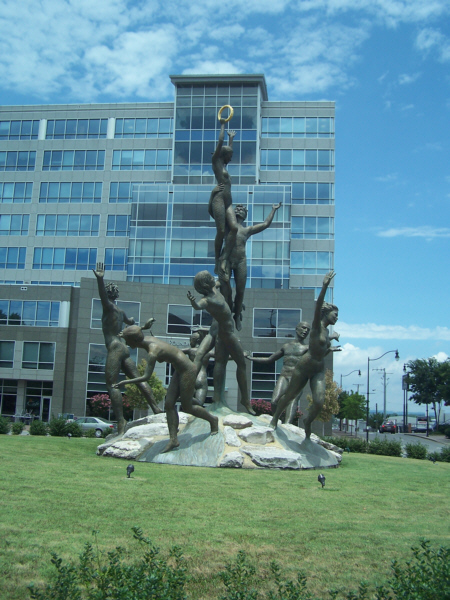 |
At the top of Music Row, the buses came to the circle surrounding "Musica." "Musica" is Alan LeQuire's largest sculpture commission to date; it features nine dancing figures in a circular composition roughly thirty-eight feet tall. There are five figures which spring forth from the base in an over-all vase form. Four more rise up in the center floating above the others. The scale of each figure is fourteen to fifteen feet, or more than twice life-size.
The dancers and part of the base is cast in bronze. The other part of the base is composed of massive natural limestone boulders. LeQuire wrote that "Dance is the physical expression of music and the piece is intended to convey that feeling to the viewer in a composition which is simple, exuberant and celebratory. The theme of the sculpture is music, because of the historical and economic significance of the site. This is the heart of Music Row, the area and the artistic activity for which Nashville is best known. The sculpture conveys the importance of music to Nashville, past, present and future, and represents all forms of music without reference to any one form or style. It is meant to provide a visual icon for the area and for the city as a whole."
"The theme is music, but the sculpture represents artistic creativity itself. An artistic idea often seems to miraculously and spontaneously burst forth. This is what happens in the sculpture, and the title 'Musica' suggest this since it refers to all the 'arts of the muses.'"
The tour buses took us down "Music Row" with all of its recording studios and record label buildings, and then across West Nashville and the Vanderbilt campus towards The Parthenon in Centennial Park.
The Parthenon in Centennial Park
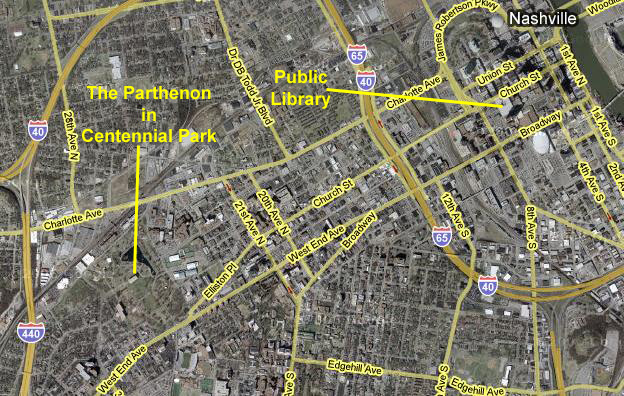 |
Arriving at the Parthenon
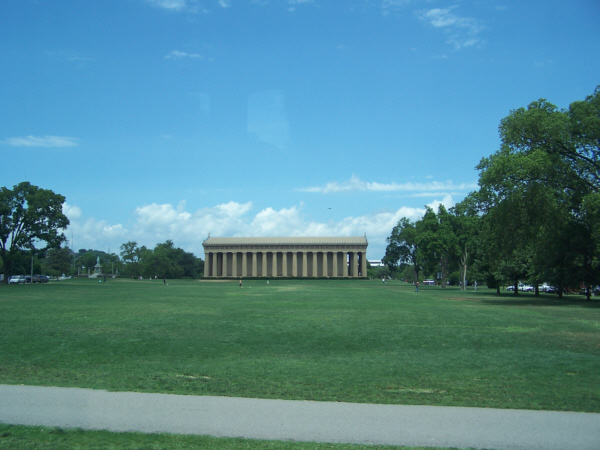 |
In 1895 Tennessee searched for a way to commemorate its 100-year anniversary and decided on a centennial exposition to be staged in its capitol of Nashville and then building an exact replica of the Parthenon of ancient Greece and thus the Parthenon, being the pinnacle of the Grand Exposition, was the first building erected. The construction of 36 other buildings followed, with the Parthenon setting the theme.
The original full-scale replica was intended as a temporary exhibit structure and was constructed of brick, wood and plaster. The building quickly endeared itself to all Nashvillians who proteested plans for the building's demolition at the close of the Centennial celebration. The original building stood until 1931 at which time the city of Nashville began the reconstruction of the worn structure- this time with permanent materials. This building, the result of those efforts, was completed in 1991. The Parthenon was listed in the National Register of Historic Places on February 25, 1972. All of the improvements are a gift of the people of Metropolitan Nashville and Davidson County and serve as a reminder of Nashville's long-standing reputation as the "Athens of the South."
Before we went inside the building, Fred and I took a number of other pictures of the outside of the building- more than I can include here. So I've selected only the best of these to show you, and you can see those full-size images by clicking on the thumbnails below:
 |
 |
 |
 |
 |
 |
The Parthenon in Nashville is the only full size replica in existence. Its huge 7-ton Bronze entrance doors on the east and west sides are the largest of their kind in the world. The column and ceiling detail is, according to the exhibits inside, is accurate to the original, assuming that the original Parthenon were restored to the condition historians think would have been evident when it was constructed and maintained. Few traces remain of any color on the original, but what traces do remain were used as a guide for the decoration of this duplicate. The pediment reliefs on both ends of the building were created from direct casts of the originals, which are housed in the British Museum of Art. The many carvings are very finely detailed, and, of course, are maintained- unlike the original ruin in Athens. The only modern addition is the protective mesh that covers the eaves carvings that prevents birds from nesting and destroying the carvings. Fred was very interested in these carvings, and on the statues at the roof corners, and he took a number of pictures of them. Below are thumbnails for the best of these, and you can see the full-size pictures by clicking on these thumbnails:
|
We took all these pictures as our group gathered across from the entrance to the Parthenon, and William Henry gave us some background on the building's design, interesting features and history. We had tickets for a particular entry time, and when that time came around, we all filed inside through the visitor entrance on the east side of the building.
The Statue of Athena Parthenos
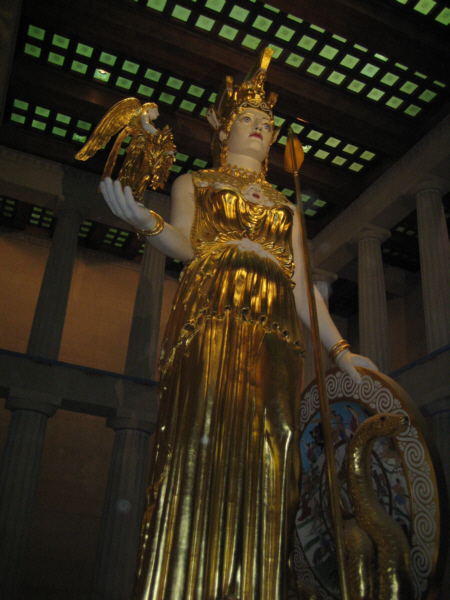 |
The statue of Athena Parthenos within is a reconstruction of the long lost original to careful scholarly standards: she is cuirassed and helmeted and carries a shield on her left arm. Standing some fifteen feet in diameter, Athena's shield is a complex sculpture in its own right. On the exterior, in high relief, is a depiction of Greek heroes and Amazons savagely contesting an unnamed Greek city. In the Greek mind, the Amazons were symbolic of other cultures- especially the Persians, whom the Greeks considered barbarians. In Greek myth, the Amazons lived in the area of Eastern Anatolia, and the long robes and effeminate manners of the Persians were likened to those of the legendary women warriors. In the center of the shield is the grotesque image of Medusa, slain by Perseus with the help of Athena; as a thank-offering for her help, Perseus gave the Gorgon's head to the Goddess, who put it on her shield as a protective device. The Medusa appears on Athena's breastplate.
There is also a small (6-foot) statue of Victory in her right palm. She is gilt with more than eight pounds of gold leaf; an equally colossal serpent rears its head between her and her shield. Of course, the original statue in Athens has been long removed from the Parthenon; this copy was created and polychromed (painted in colors) as close to the presumed original as possible.
The lighting and the crowds inside made it difficult to get good, well-lighted and well-staged pictures of the Athena statue, but Fred was able to get some decent ones. One of them shows all the elements of the sculpture- Athena and her spear, Victory, the shield and the serpent. A second one shows the upper portion of the Athena Parthenos in closeup. And the last shows an interesting view of Athena Parthenos from the back.
Inside Exhibits and Features
In the summertime, local theatre productions use the building as a backdrop for classic Greek plays such as Euripides' Medea and Sophocles' Antigone, performing (usually for free) on the steps of the Parthenon. Other performances, such as Mary Zimmerman's Metamorphoses, have been done inside, at the foot of Athena's statue. The Parthenon served as the location for the political rally in the climactic scene of Robert Altman's 1975 film "Nashville."
The inside architecture is really quite interesting. Although historians can only guess at what the interior of the Parthenon must have looked like, these educated guesses have been brought to life inside the Nashville Parthenon. For example, it is thought that the interior columns supported a ceiling made mostly of wood; even though the lighting used here is obviously a modern addition, the structure of the columns and ceiling, captured by Fred in two pictures here and here, are at least representative of what might have been found in the original. One thing that is known about the original is that it had tall bronze doors, and these bronze doors have been recreated here, with appropriate decoration. As it turns out, these are the tallest bronze doors in the world- over forty feet high.
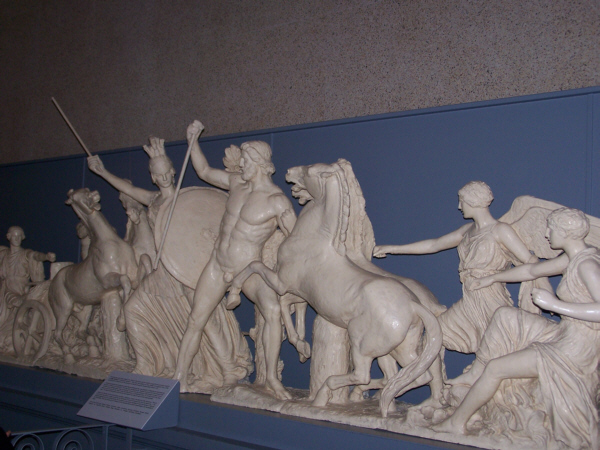 |
I took a movie of each of these models, and I have also transcribed the explanatory sign for each of them. If you are interested, you can read the descriptions of each model and look at it using the movie player alongside the description.
|
|
We see that Athena's birth occurred at dawn because Helios, god of the sun (left corner), is emerging over the horizon with four steeds that will pull his flaming chariot across the sky, while his sister Selene, goddess of the moon, (right corner), is descending into the sea.
The central figures (those between Iris on the left and Hestia-Dione-Aphrodite on teh right) were removed during the conversion of the Parthenon to a Christian church in the fifth century AD, and so it is nearly immpossible to know exactly how many figures representing which gods and goddesses were in the original grouping. This version is one of several acceptable interpretations of the 1920s, but contains the contemporary identification of the group of three women to the right of Apollo.
Figures from left to right: Helios, Dionysus, Persephone, Demeter, iris, Poseidon, Hebe, Aphrodite, Hephaestus, Zeus, Nike, Athena, Area, Artemis, Hera, Hermes, Apollo, Ganymede, Hestia, Dione, Aphrodite and Selene.
|
|
Athena and Poseidon are the central figures and each is flanked by a chariot, charioteer and other supporters. There is much controversy among scholars concerning the identification of most of the figures other than the central two. In the Nashville pediment the two outermost figures are river gods and the mortals represent the two royal families of Kekrops and Erechtheus. The outer figures are now missing from the maquette and are listed in parentheses in the list of figures. The figures are, from left to right" (Lissos), Kekrops, Pandrosos, Herse, Erysichthon, Agiauros, Erectheus, Hermes, Athena, Poseidon, Iris, Amphitrite, Kalais, Orelthyia, Zetes, Melicertes, Ino, thalassa, (Callirrhoe) and (Kephissos).
Leaving the Parthenon
 |
 |
 |
 |
 |
 |
 |
|
|
We reached the buses and were driven back to the Public Library, where we got the car out of the parking lot and went over to the Country Music Hall of Fame, intending to spend the afternoon there.
When we got to it, just a few blocks away in downtown, we found it was closed for a "private event," and so we just got in the car and started for home.
Sunday, June 29: We Stop for Dinner in Little Rock, Arkansas
 |
We had not yet found a place when we came to a pedestrian bridge across the river; it connected Little Rock and North Little Rock. Even though we hadn't yet eaten, we thought that since we were here, we would go across the bridge and back and take some pictures. The bridge is an old railroad bridge that has been renovated for pedestrian use. You can see the portion that used to go up and down to allow ships to pass underneath; this mechanism does not work anymore, and elevators and stairs have been placed at both ends since the bridge is now permanently in the "up" position.
Soon after we got out on the bridge, we ran across some middle‑aged cyclists going across, and we stopped them to ask for recommendations as well. Finally, we got a couple of decent suggestions, and it turned out that all of them were across the river in North Little Rock- but within easy walking distance from the north end of the bridge. So we headed on across the bridge, getting some good pictures in the process. Use the links below to look at some of these pictures:
Me on the bridge looking southeast towards the Clinton Library
Me on the bridge looking north towards North Little Rock
Fred on the bridge looking southwest towards downtown Little Rock
Downtown Little Rock
The restaurant we settled on was Cregeen's Irish Pub, and it turned out to be quite good with lots of atmosphere- although it wasn't terrifically busy on this Sunday night. This area of North Little Rock seemed to be undergoing a lot of renovation. There was a new convention center and some new condos, and it looked as if many of the shops and restaurants were relatively new. Just outside the restaurant we were able to get a typical North Little Rock street view.
On the way back to the pedestrian bridge, Fred found some plants he wanted cuttings of, and I found a discarded Styrofoam cup to carry them in back to the car. Crossing the bridge back to Little Rock, we got some additional pictures. Parked at the edge of the river, just below the bridge, there was an old submarine, but no sign to tell us if it was going be a floating museum or something else. Just before descending on the Little Rock side of the bridge, Fred got a really nice picture of sunset over the Arkansas River.
Running along the south side of the river there is a strip park, and I would imagine it goes all the way along to the new Clinton Library, but we did not have time to explore it. Fred did get a picture of a bandshell as we passed it on the way back to the car.
The meal in Little Rock was quite good, and now all we had to do was drive about four more hours to get home, which we did just after one in the morning. It was a really interesting trip, what with the conference and all, but the waterfalls, the Nashville tour and the dinner in Little Rock really rounded out the long weekend.
You can use the links below to continue to another photo album page.
 |
July 4, 2008: 4th of July at Ron Mathis's House |
 |
June 13-16, 2008: The Texas Folklife Festival in San Antonio |
 |
Return to Index for 2008 |